https://www.blackgate.com/
An Eternal Champion’s Legacy: 64 Years After his Debut, Fantasy’s Original Edgelord Still Reigns Supreme
Paperback editions of the first six Elric books (DAW Books, 1972 – 1977). Covers by Michael Whelan
It may not seem like it, but this winter has given fans of fantasy plenty to celebrate. Less than a month ago, Michael Moorcock turned 84, his most recent Elric novel turned three, and the latest reprint of his vaunted Eternal Champion series hit store shelves in the US. Thanks to a boatload of new collections, there is no better time to be a fan of the pale emperor. Or, for that matter, to look into his legacy.
Suffice to say that Moorcock’s legendary career has been full of incredible characters. His influence can be seen among the finest rogues of the Sword Coast and in tales spun in the far-flung wine sinks of Essos. Nowhere is that more noticeable than with his most famous creation, Elric of Melnibone. When his early stories made their way into the hands readers in the 60s and 70s, the impact would prove seismic. Today those same readers are academics, authors, and gamers happy to see Elric influence another generation.
[Click the images for Champion versions.]
“It stuck out from any other fantasy book I’d read,” Derik Petrey shared the moment Elric of Melnibone was brought up.
The Chair of Humanities at Sinclair Community College recalls that first encounter with the emperor of dragon isle vividly. Like so many other readers in the 80s, Moorcock’s style and characters proved as addictive Imrryr’s dream couches.
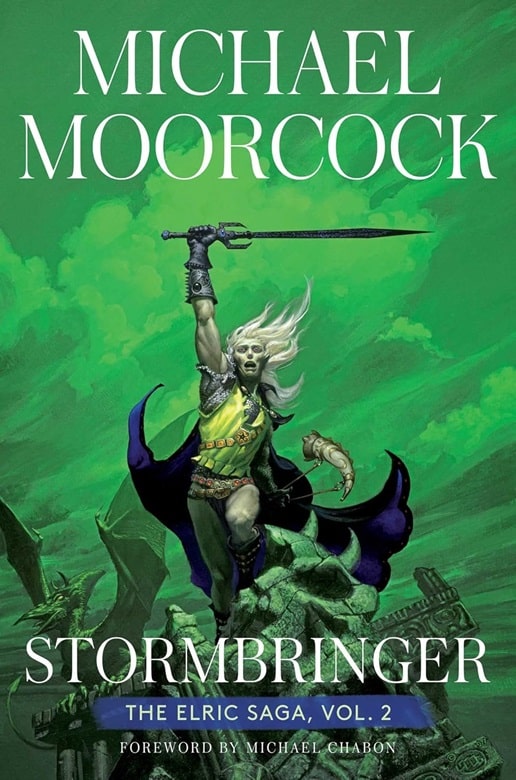
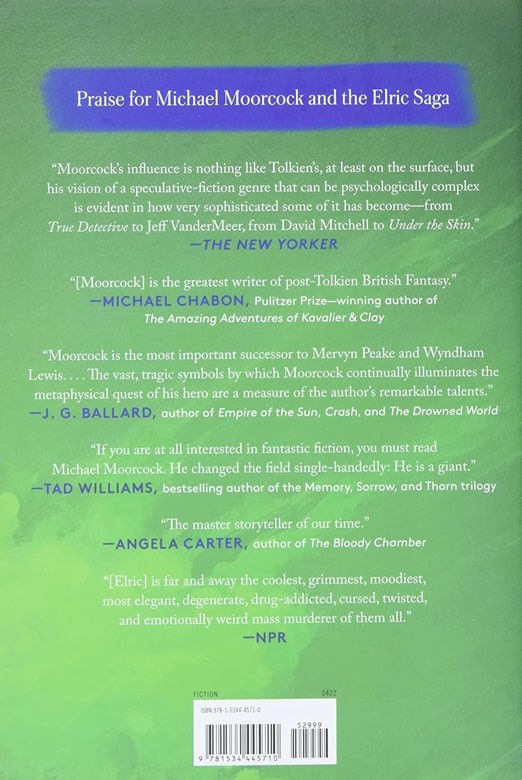
The Elric Saga, Volume 2: Stormbringer , an omnibus containing the novels
Stormbringer (1965), The Vanishing Tower (1977), The Bane of the Black Sword (1977),
and The Revenge of the Rose (1991). Saga Press, April 12, 2022. Cover by Michael Whelan
“He was really the first antihero that I’d read and could wrap my head around. There was this sense that ‘oh this person has all sorts of flaws.’ He’s addicted to drugs, longs to marry his cousin, and keep her from her brother,” Petrey remembered.
The years 1983-1984 would see him read Elric of Melnibone and The Sailor on the Seas of Fate. In an age where the works of JRR Tolkien and CS Lewis were the example other authors followed, Moorcock became a patron saint of literary rebels.
“He (Elric) did not have the values of a Tolkien-esque character. You have his dependency on a sword, a living weapon, and also this love-hate relationship with Arioch that was really uncommon.”
Sci-fi fans of Petrey’s vintage look around and see a landscape transformed by the pale swordsman. Other Eternal Champions were great characters, but to Petrey, neither Corum, Dorion Hawkmoon, or any of the others held a candle to Elric.
“It was very much conveyed to me that this was a non-human civilization. It’s this idea of how you communicate how different a society would be,” Petrey said. “There were very few science fiction writers that treated aliens as truly alien. You had Jack Vance, Larry Niven, and Moorcock.”
Elric’s modern-day revival speaks to the enduring power of Moorcock’s writing. Recent years have seen entirely new generations of readers take to the original White Wolf of Fantasy.
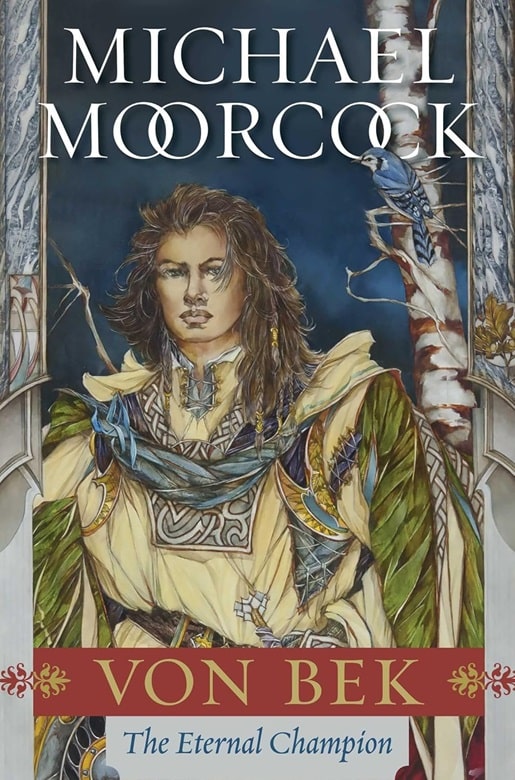

Von Bek: The Eternal Champion omnibus, containing The Warhound and the World’s Pain
and The City in the Autumn Stars (Saga Press, December 3, 2024). Cover by Tom Canty
It wasn’t so long ago that simply finding certain editions of the Elric saga were a challenge. The number of anthologies, collections, and iterations of his stories can be staggering. Untangling the publication history of Elric for this article left me bewildered at times. Without the recent wave of reprints, reading those stories would be just as much of a challenge.
That would change in 2022. Starting in Feb. of that year, Saga Press announced they would be releasing new collections of Moorcock’s work starting with the Kinslayer himself. Last December, fellow Eternal Champion Von Bek received the same loving treatment when The Warhound and The World’s Pain returned to bookshelves. The well-made collections have made the jobs of Booktubers peddling the proverbial Book of Elric that much easier.
“I think Elric’s sustained popularity over more than 60 years owes much to Moorcock’s transgressive bent. He upended, or amplified beyond convention, traditional tropes of speculative fiction, including the monomyth (the hero’s journey),” Bridger, from the Library Ladder YouTube channel, shared by email.
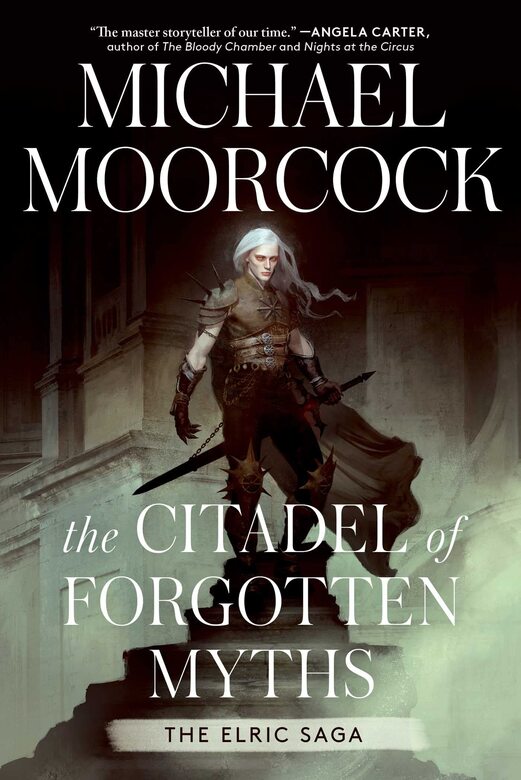
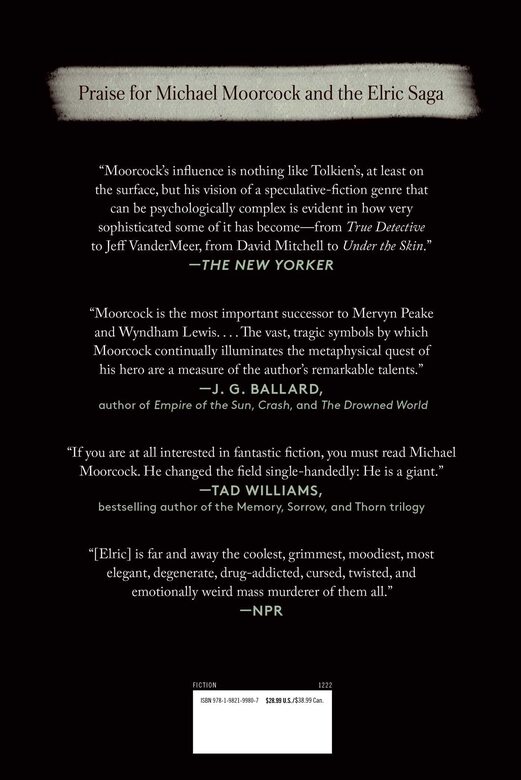
The Elric Saga: Citadel of Forgotten Myths (Saga Press, December 6, 2022). Cover by Bastien Lecouffe-Deharme
He is one of many helping introduce Elric and his fellow champions to readers online. His four Moorcock-specific videos alone have garnered over 160,000 views.
At just 12, he would begin his journey alongside Imrryr’s most famous citizen with the DAW paperback editions, with their beautiful Michael Whelan covers. Completing the first Thomas Covenant Trilogy — Lord Foul’s Bane, The Illearth War, and The Power That Preserves — would serve as good preparation for Elric.
“Elric and Covenant seemed almost like two sides of the same coin. Both were moody, morally ambiguous, endowed with awesome powers they feared, and prone to occasional outbursts of primal, uncontrolled violence. But I found Elric less abrasive, easier to identify with, and more willing to take decisive action when situations called for it. They were significant departures from any heroic characters I’d encountered up to then,” Bridger explained.
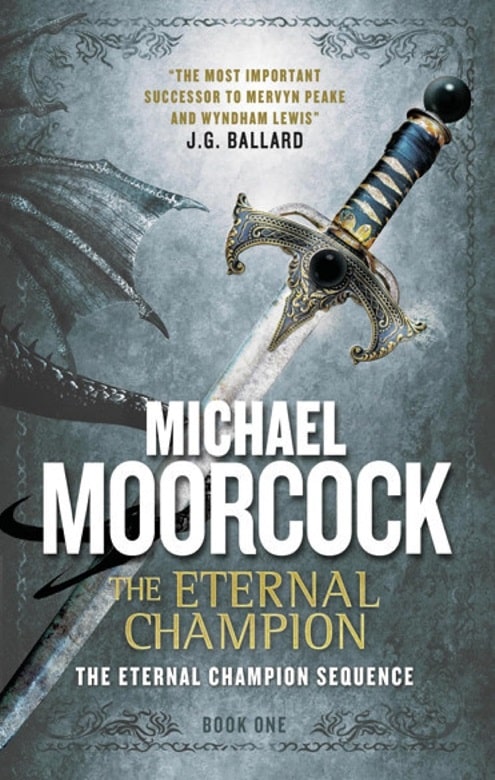
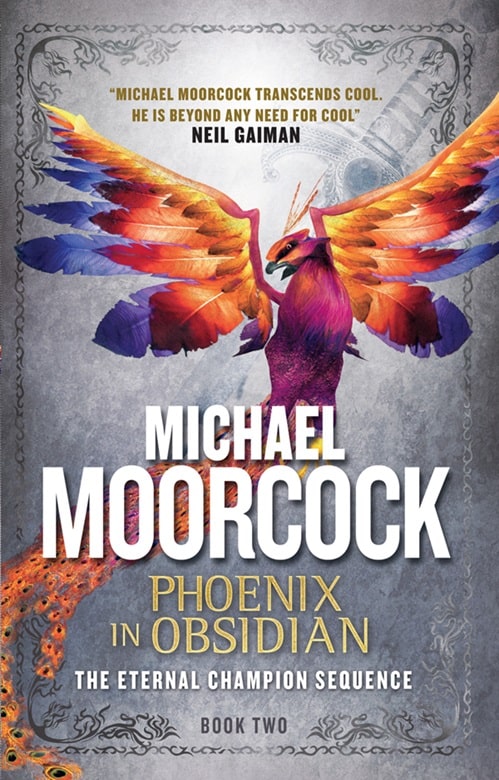
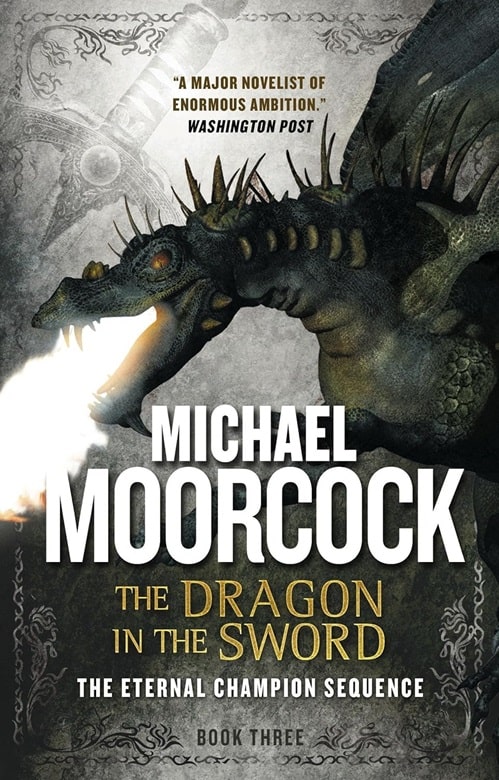
The Eternal Champion Sequence: The Eternal Champion, Phoenix in Obsidian, and
The Dragon in the Sword (Titan Books, November 2014). Covers uncredited
Like many readers, Bridger would return to the classic character time and again. Moorcock’s remarkable ability to churn out one story after another helped keep Elric current and fresh.
“In Elric, Moorcock took many of those qualities to extremes relative to typical fantasy heroes. His moods are darker. His weaknesses more debilitating. His impulses more consequential. His betrayals and revenges more bloody. And the stakes are higher, as he strives to save not just one world, but an entire multiverse of them,” Bridger shared.
He sees Elric’s legacy across the genre and beyond. And it is a legacy not just limited to books. His influence can be seen in video games, on tabletops, big and small screens.
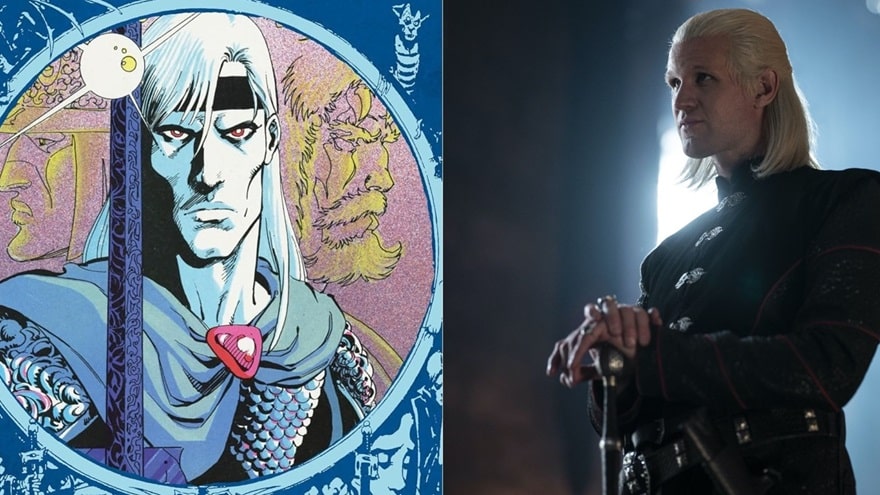 Elric and House of the Dragon‘s Daemon Targaryen. Art by Jan Duursema, from The Michael Moorcock Library Vol. 5: Elric The Vanishing Tower (Titan Comics, August 8, 2017). Daemon Targaryen photo by Ollie Upton.
Elric and House of the Dragon‘s Daemon Targaryen. Art by Jan Duursema, from The Michael Moorcock Library Vol. 5: Elric The Vanishing Tower (Titan Comics, August 8, 2017). Daemon Targaryen photo by Ollie Upton.
“There are some obvious parallels between Elric and later albino characters in fantasy fiction such as R.A. Salvatore’s drow elf Drizzt, Andrei Sapkowski’s Geralt the Witcher, and several members of George R.R. Martin’s Targaryen family tree, with their special abilities and complicated personalities,” Bridger detailed, explaining that the albino trope was itself borrowed from Sexton Blake’s Monsieur Zenith.
Roland Deschain of Stephen King’s Dark Tower series and Tyrion Lannister from A Song of Ice and Fire are two other characters that remind Bridger of the Eternal Champion. For Petrey, its Death from The Sandman that reminds him most of Elric. Both see the industry as being much richer due to the author’s influence.
“There’s an authenticity in Moorcock’s work. He himself is an iconoclast, he loves taking conventions and smashing them and I think that’s refreshing every once in awhile,” the professor stated.
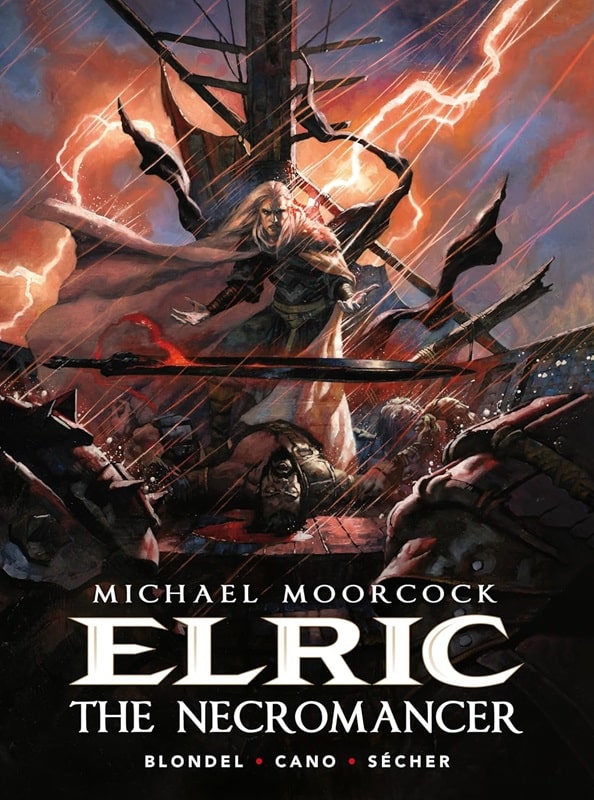 Michael Moorcock’s Elric Volume 5: The Necromancer, written by by Julien Blondel and illustrated by Valentin Sécher (Titan Comics, December 31, 2024).
Michael Moorcock’s Elric Volume 5: The Necromancer, written by by Julien Blondel and illustrated by Valentin Sécher (Titan Comics, December 31, 2024).
A six-decade run doesn’t happen by accident. If Elric proves anything, it’s that with the pale prince of ruins Moorcock was able to capture the magic that continues to enchant lovers of the genre.
“These are characters that have their own lives. I don’t want to be like Elric but his stories help me imagine what living that life, at that time, and in those societies would be like,” Petrey said.
What a Croc, Part I
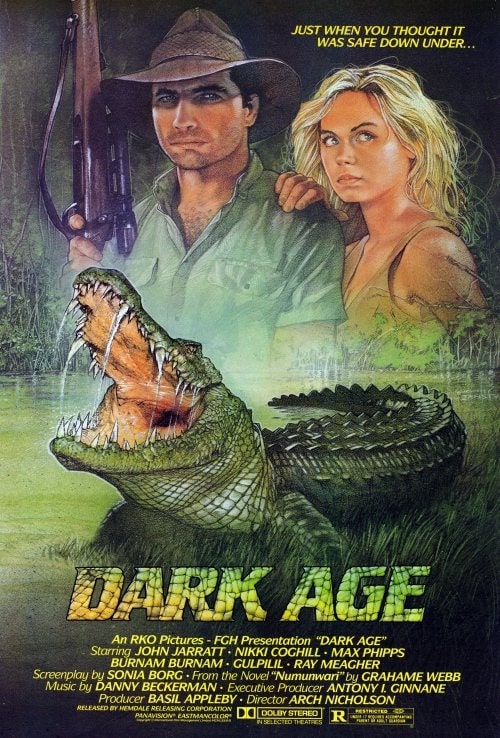 Dark Age (Embassy Home Entertainment, July 10, 1987)
Dark Age (Embassy Home Entertainment, July 10, 1987)
My next watch-a-thon is a favorite genre: crocs and gators. Unfortunately, this means the pickings are a bit slim, as I’ve already seen most of them, but I’ve managed to dig up 15 so far (supplemented with a Gila Monster and a couple of Komodos), and I’m sure the intended list of 20 will materialize as streaming services start suggesting titles.
Dark Age (1987) YouTubeCroc or gator? A 25ft saltwater crocodile.
Real or faker? A lovely, animatronic behemoth.
Any good? A thoroughly decent offering from the Ozploitation market, Dark Age is far from a mindless bloodbath sprinkled with spring breakers, and instead does what most Australian horror does: provide thrills alongside a biting social commentary. The croc in question is Numunwari, considered a God by the local Aboriginal population, but the extremely unpleasant white folks just see it as a trophy for their walls. Doubly so after it kills several people (including a rather unsettling attack on a young child).
The only decent non-Aboriginal character is Steve Harris, a conservationist, played by John Jarrett (who would go on to sever spinal cords 18 years later in Wolf Creek). He strives to find a way to stop the croc without killing it, and so begin the saltwater shenanigans. It’s well made, speckled with nods to Jaws throughout, and apparently a favorite of Tarantino’s. Loved it –- off to a great start!
8/10
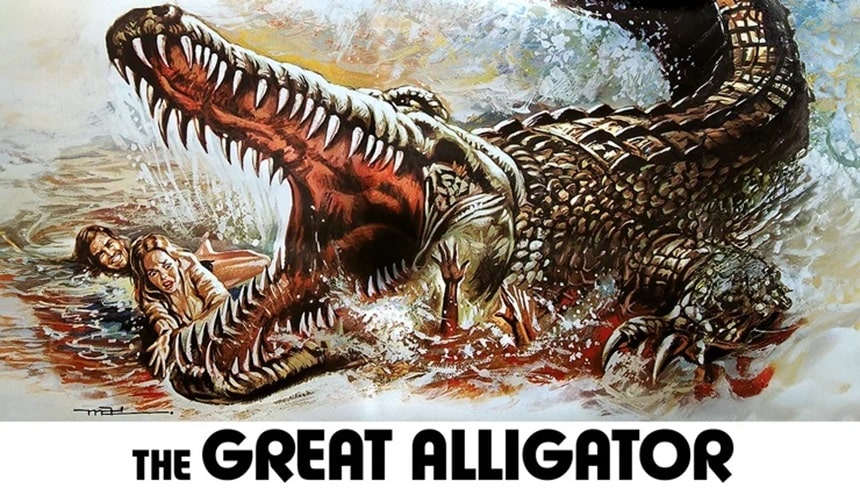 The Great Alligator (Medusa Distribuzione, November 1979)
The Great Alligator (1979) YouTube
The Great Alligator (Medusa Distribuzione, November 1979)
The Great Alligator (1979) YouTube
Croc or gator? Actually a crocodile.
Real or faker? A big ol’ chonky puppet.
Any good? Warning: being a late 70s Italian ‘shocker’, this film kicks off with a bit of animal cruelty (not on the level of of a Deodato film though) and plenty of bare norks.
That said, it’s an enjoyable romp, backed up with a funky bongo soundtrack, and starring Mel Ferrer and Barbara Bach (dubbed throughout, even though the film is in English). The film concerns another croc God, this time an African one (the film was actually shot in Sri Lanka and features wildlife stock footage from Borneo).
Like Dark Age, the film concerns itself with more than just an angry reptile; environmentalism, colonialism and capitalism are all thoroughly speared (literally). There’s a great deal of ‘white savior vs. the savages’ going on, but it’s not too ugly, and all the racists get a decent comeuppance. The giant croc itself is astonishingly tame, more of a pool floaty than a killing machine, but it does chew the shit out of a VW camper van, so I applaud its efforts. I had fun.
7/10
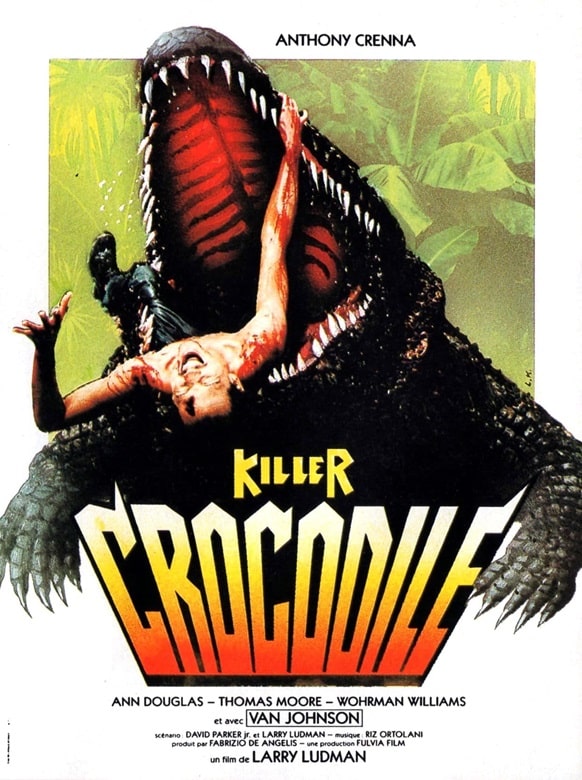
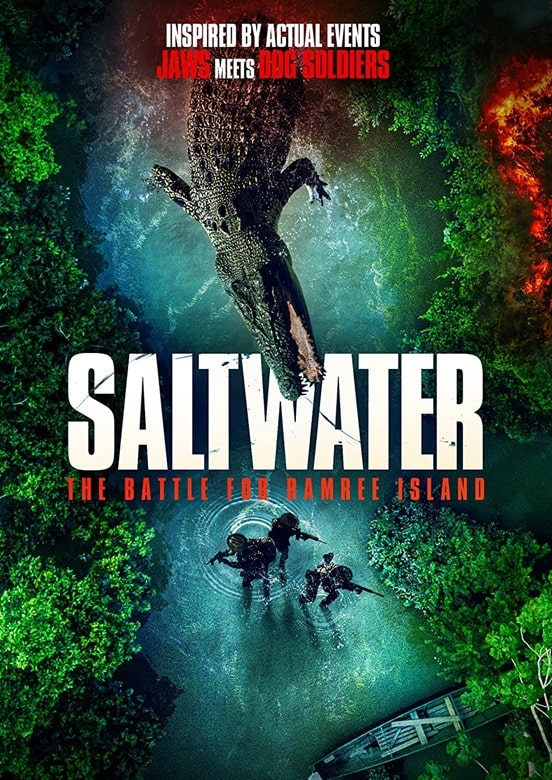
Killer Crocodile (Fulvia Film, July 30, 1989) and Saltwater: The Battle for Ramree Island (Creativ Studios, June 1, 2021)
Croc or gator? Crocodile.
Real or faker? A hilarious puppet.
Any good? Another Italian production to join the plethora of Jaws rip-offs, and another similar plot. This time a group of peace-loving tree-huggers are in an unspecified locale (actually the Dominican Republic) to investigate a polluted river. The toxic waste is not only bad for fish but bad for humans, as it has mutated a croc into a canvas coated styrofoam puppet that eats everything it sees with its googly eyes.
Cue some more white saviors saving the dark-skinned locals, a corrupt baddie getting his comeuppance and Lee Van Cleef-Lite jumping on the back of the titular beast and surfing it under the waves. A bit of good gore, a lot of bad acting and a soundtrack that sounds like the producer’s uncle farting into a tuba. Solid euro-trash. I liked it.
6/10
Saltwater: The Battle for Ramree Island (2021) PrimeCroc or gator? Crocodile(s).
Real or faker? Stock footage and a hand puppet…
Any good? Burma, 1945. Stories are told of a Japanese base on the island of Ramree that was overrun by saltwater crocodiles, leaving only 20 men alive out of a total of 1000. It’s based on fact, but the numbers have been wildly exaggerated.
That said, it would make a really interesting film as told from the Japanese point of view. Instead, we get a low-budget snooze-fest that could only afford two Japanese actors after shelling out for its four principal cast members. An inept squad of British soldiers (including one from the 77th Indian Infantry Brigade) are on a secret mission. So secret that three of them don’t know why they are there.
This squad makes Dad’s Army look like the S.A.S. — terribly written, 2-dimensional cliches (the befuddled old sergeant, a racist private, the quiet one (actually called Private Pike) and a very nice Indian) — and they soon find themselves up to their chewed knees in crocs. Way too much talking, not enough chomping.
Don’t believe that tagline. Dull.
5/10
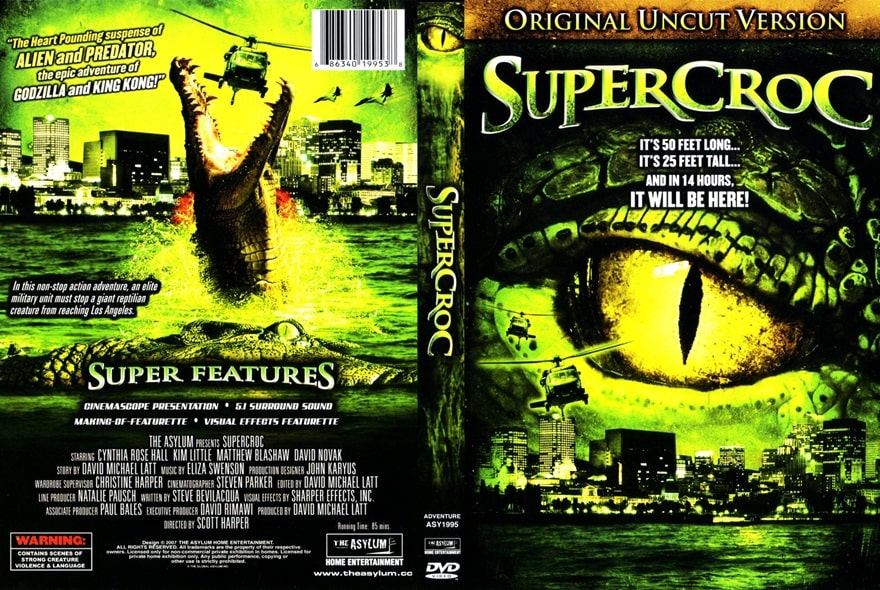 Supercroc (The Asylum, April 3, 2007)
Supercroc (2007) Tubi
Supercroc (The Asylum, April 3, 2007)
Supercroc (2007) Tubi
Croc or gator? Crocodile.
Real or faker? Terrible CG.
Any good? I’m dragged kicking and screaming back to the reality of low budget crap by this one from 2007. Horribly shot (all extreme close ups or unfocused wobbly-cam), Supercroc is about a less-than-super crocodile that has decided to lay some eggs and go on the rampage. The US military machine (a bunch of soldiers in a park) try to stop it and mostly get eaten.
It’s dull, full of mismatched military stock footage, and the CG is abysmal — case in point, the 50ft reptile slides into the water with nary a ripple. Not good.
3/10

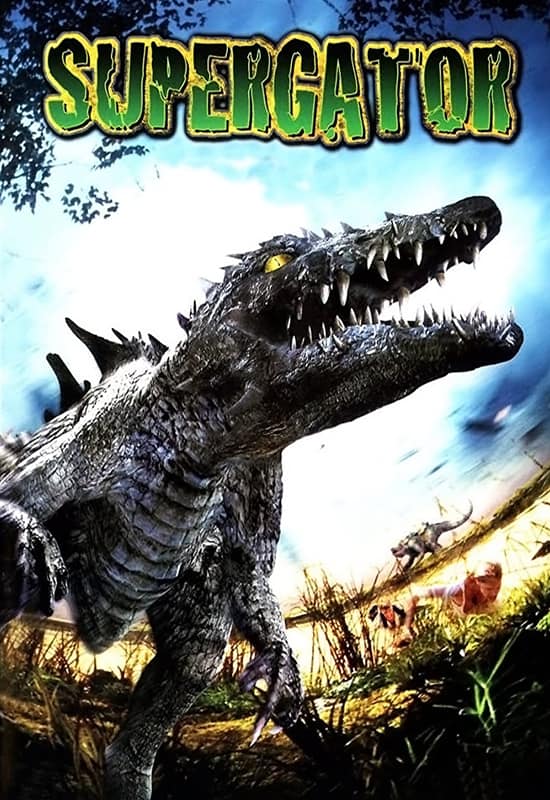
Crazy Tsunami (Splendid Film, 2021) and Supergator (Rodeo Productions, 2007)
Croc or gator? Crocodile.
Real or faker? Combo CGI and floaty puppet.
Any good? A Chinese production, keeping their recent fondness for glossy monster movies on the boil, this one is obviously inspired by the brilliant Crawl and the equally fun Aussie shark flick, Bait. In it, a freak tsunami in Indonesia floods Chinatown, and leaves a group of survivors fending off an African crocodile, which was being transported to a private collection.
Throw in some unscrupulous building developers, and you have a recipe for extremely moist mayhem. It’s derivative and hokey, and yet I really enjoyed it. Might be my favorite so far.
7/10
Supergator (2007) YouTubeCroc or gator? Alligator. Sort of.
Real or faker? Rubbish CGI.
Any good? Nope. Hot on the heels of Dinocroc, Roger Corman wanted to make a sequel, but SyFy said no. So he made it anyway, tweaked the monster design, had a nice few weeks in Hawaii, and produced this bit of tripe.
Kelly McGillis is the big name in this one, and she suffers through a tired script, hokey acting and lousy effects. It’s hard to judge a film like this, I’m not watching it for plot or character development and I guess if I was a 15-yr-old horndog I could grade the knocker quota, but in the end all I can ask is: was I entertained?
No, I wasn’t.
4/10
Previous Murkey Movie surveys from Neil Baker include:
Prehistrionics
Jumping the Shark
Alien Overlords
Biggus Footus
I Like Big Bugs and I Cannot Lie
The Weird, Weird West
Warrior Women Watch-a-thon
Neil Baker’s last article for us was Prehistrionics, Part III. Neil spends his days watching dodgy movies, most of them terrible, in the hope that you might be inspired to watch them too. He is often asked why he doesn’t watch ‘proper’ films, and he honestly doesn’t have a good answer. He is an author, illustrator, outdoor educator and owner of April Moon Books (AprilMoonBooks.com).
Goth Chick News: The Hairy Problem of Werewolf Movies
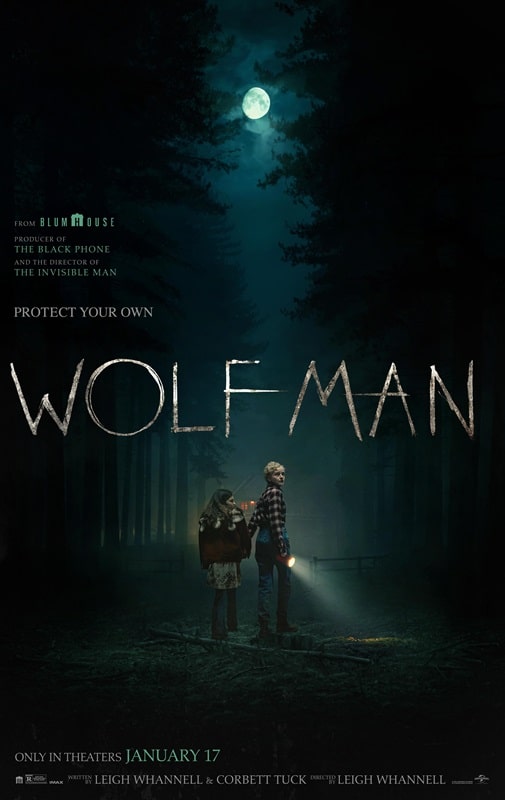 Wolf Man (Universal Pictures, January 17, 2025)
Wolf Man (Universal Pictures, January 17, 2025)
Why oh why can’t Hollywood produce a decent werewolf movie?
I’ve had my heart broken twice in the past few months, first by The Beast Within (2024) and most recently by Wolf Man (2025).
I first told you about The Beast Within starring Kit Harington, back in August. In summary, it was lousy. Though the trailer implied a suspenseful, cohesive tale, Beast was a rambling affair that didn’t seem to know what it wanted to be. As for an actual werewolf transformation, it was implied but never really materialized. Instead, director Alexander J. Farrell tried to distract us from this fact with a knee-jerking series of events that barely held together as a story. Even putting Harington half-naked in a dog collar wasn’t enough to make me forgive this mess.
So, if you tell me I should have known better when, with renewed hope, I ran off to the theater last weekend to see Wolf Man, I wouldn’t argue.
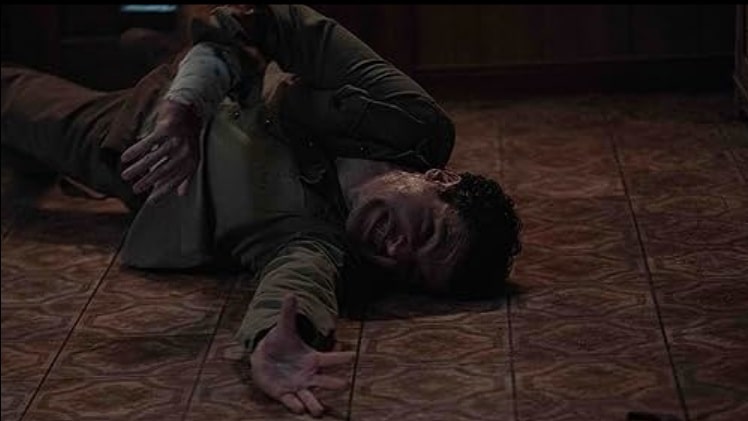 Wolf Man
Wolf Man
Making another attempt at revitalizing the classic monsters franchise ahead of opening its “Dark Universe” park in May, Universal Studios got behind this werewolf movie produced by Blumhouse, which made me think there was a chance it would be good. Afterall, it was Jason Blum who inspired Universal to give their Dark Universe movie franchise another go after Tom Cruise’s The Mummy was an unmitigated atrocity.
Universal had scrapped all the big-budget monster remakes they had teed up, which was more than fine with most fans, including me. Then here comes indie production company Blumhouse, hitting a home run with The Invisible Man (2020). Making nearly $145M on a $7M budget that’s a 20x return, meaning Hollywood couldn’t throw new projects at Jason Blum fast enough. When I heard Blumhouse had been handed the remake of Wolf Man (1941) I dared to be cautiously optimistic.
What a mistake.
I can count on one hand the number of times I’ve sat in a theater looking at my watch. I nearly always find something to love about most movies, but Wolf Man was so awful I would have got up and left had it not been for the tiny flame of hope I had that maybe the ending would redeem my two-hour investment.
It didn’t.
Here’s how Universal described Wolf Man:
Golden Globe nominee Christopher Abbott (Poor Things, It Comes at Night) stars as Blake, a San Francisco husband and father, who inherits his remote childhood home in rural Oregon after his own father vanishes and is presumed dead. With his marriage to his high-powered wife, Charlotte (Emmy winner Julia Garner; Ozark, Inventing Anna), fraying, Blake persuades Charlotte to take a break from the city and visit the property with their young daughter, Ginger.
But as the family approaches the farmhouse in the dead of night, they’re attacked by an unseen animal and, in a desperate escape, barricade themselves inside the home as the creature prowls the perimeter. As the night stretches on, however, Blake begins to behave strangely, transforming into something unrecognizable, and Charlotte will be forced to decide whether the terror within their house is more lethal than the danger without.
Sounds promising right? And for the first 20 minutes or so it kind of was. The dialog was lame, but the premise was interesting. En route to the childhood home in the middle of nowhere, the family gets into an accident and as they extricate themselves from the wreckage, the dad is bitten by an animal that runs off before they get a good look. Que the slow transformation of the dad into a werewolf which could have been awesome but instead was so drawn out and mind-numbingly boring it made me angry.
And come on – we had two fabulous werewolf movies back in the 80s in the form of The Howling (1981) and American Werewolf in London (1981), so someone in Hollywood must have kept the instructions on how to create a credible werewolf transformation with practical effects.
 Wolf Man
Wolf Man
But no. Wolf Man not only failed in its plot and dialog, but it utterly and completely defecated the mattress in creating an even remotely interesting werewolf.
So why does Hollywood keep getting werewolves wrong? The answer might lie in their complexity. Werewolves require nuance, and filmmakers seem allergic to it. Moreover, there are considerable technical challenges of depicting a werewolf convincingly. While CGI can be incredible, the extreme overuse of computer effects has resulted in a bit of audience backlash, causing filmmakers to go back to practical effects which clearly can’t keep pace with a modern audience’s expectations.
Finally, there’s a lack of fresh ideas. Perhaps it’s time for filmmakers to take inspiration from outside the box—or at least hire a scriptwriter who doesn’t think “lycanthropy” is just a fancy word for mood swings.
Despite these missteps, there’s still a tiny glimmer of hope for us werewolf fans. Enter Robert Eggers, the visionary director behind Nosferatu (which I’ve seen multiple times and absolutely loved – more on that next week). Eggers has announced his next project, Werwulf, will be a period horror film that promises to blend folklore, psychological terror, and meticulously crafted visuals into the ultimate werewolf tale.
Fans of Eggers know his penchant for historical authenticity and atmospheric storytelling, which could make Werwulf the fresh take that the genre desperately needs. With Eggers at the helm, there’s genuine hope that audiences will finally get a werewolf film that balances primal horror with emotional depth.
Hollywood, the ball’s in your court. But for now, maybe leave the werewolves alone for a bit. They deserve a better cinematic fate than what they’ve had recently.
The Sword and Planet of Edgar Rice Burroughs, Part I
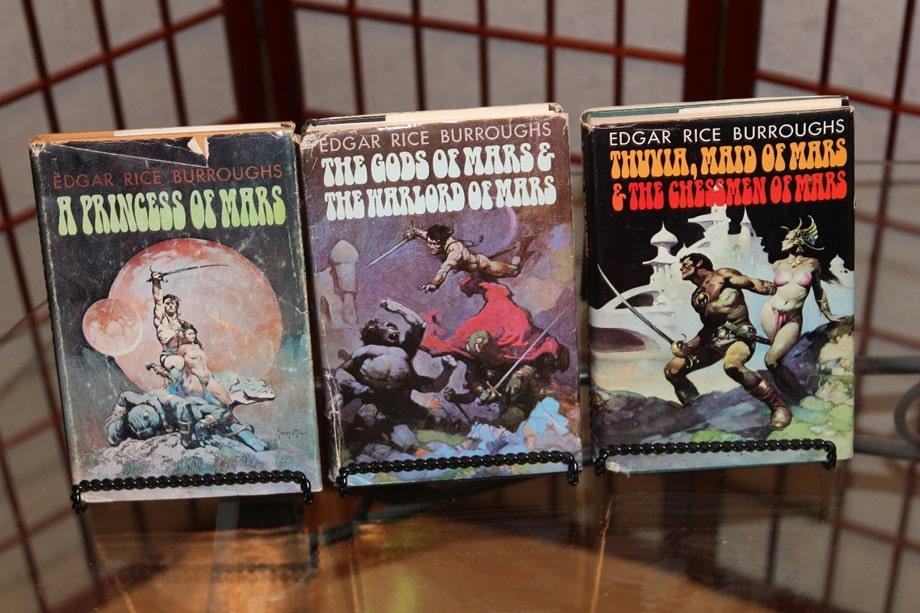 Edgar Rice Burroughs’ Barsoom novels: A Princess of Mars, The Gods of Mars and The Warlord of Mars, and Thuvia, Maid of Mars and The Chessmen of Mars (Science Fiction Books Club, July 1970, January 1971, and January 1973). Covers by Frank Frazetta
Edgar Rice Burroughs’ Barsoom novels: A Princess of Mars, The Gods of Mars and The Warlord of Mars, and Thuvia, Maid of Mars and The Chessmen of Mars (Science Fiction Books Club, July 1970, January 1971, and January 1973). Covers by Frank Frazetta
For sheer fun and adventure there’s nothing better in my opinion than Sword & Planet fiction (also called Interplanetary Adventure, Interplanetary Romance, or Planetary Romance). But exactly what is Sword & Planet fiction? Well, Edgar Rice Burroughs (ERB) created the prototype in 1911 with A Princess of Mars, which featured an Earthman named John Carter who is mysteriously transported to Mars, called Barsoom by its inhabitants.
The basic Sword & Planet story involves an earthman (rarely an earthwoman up to this point in time; 2025) on a strange world where he must use his wits, his muscles, and his sword against a host of human and nonhuman foes. The hero is generally chivalrous and the setting is an exotic alien world, often with multiple suns or multiple moons, populated by a variety of strange plants, animals, and intelligent beings. Magic is virtually non-existent, but there may be elements of “super-science,” such as open-decked flying ships or even ray-guns, although the latter take second billing to the blade. The emphasis is on swashbuckling sword fights, wild escapes, and desperate rescues.
[Click the images for Mars-sized versions.]
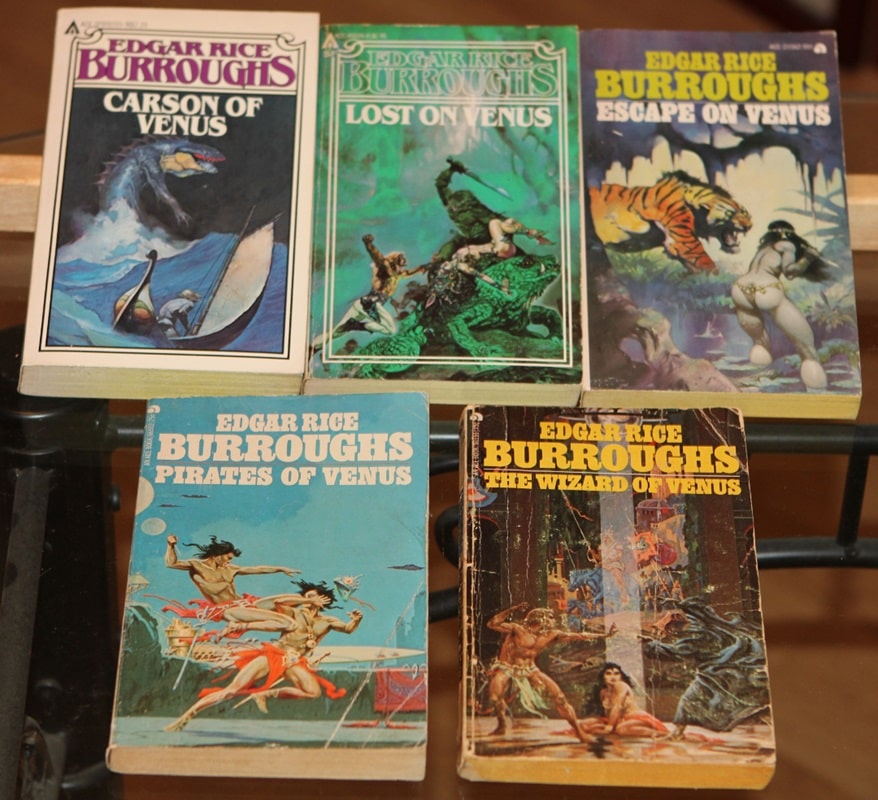 Edgar Rice Burroughs’ Venus novels: Carson of Venus, Lost on Venus, Escape on Venus, Pirates of Venus, and The Wizard of Venus (Ace Books, June 1979, June 1979, January 1974, March 1973, and January 1973). Covers by Frank Frazetta, Esteban Maroto, Frazetta, Roy G. Krenkel, and Roy G. Krenkel
Edgar Rice Burroughs’ Venus novels: Carson of Venus, Lost on Venus, Escape on Venus, Pirates of Venus, and The Wizard of Venus (Ace Books, June 1979, June 1979, January 1974, March 1973, and January 1973). Covers by Frank Frazetta, Esteban Maroto, Frazetta, Roy G. Krenkel, and Roy G. Krenkel
In addition to the Barsoom books, ERB also wrote a second Sword & Planet series, five books set on Venus (Amtor to the natives), featuring the earthman Carson Napier. Napier is intending to fly a rocket ship to Mars but ends up crashing on cloud-covered Venus.
He finds a world of giant trees and strange creatures, and, of course, a princess. Her name is Duare. Like Barsoom, Amtor mixes the primitive with super science, but the emphasis is on action, adventure, and personal combat with edged weapons.
 Escape on Venus, The Moon Men, Pirates of Venus, A Fighting Man of Mars, and The Chessmen of Mars (Ace Books, 1964, October 1962, January 1963, March 1963, and December 1962). Covers by Roy G. Krenkel, Ed Emshwiller, Krenkel, Krenkel, and Krenkel
Escape on Venus, The Moon Men, Pirates of Venus, A Fighting Man of Mars, and The Chessmen of Mars (Ace Books, 1964, October 1962, January 1963, March 1963, and December 1962). Covers by Roy G. Krenkel, Ed Emshwiller, Krenkel, Krenkel, and Krenkel
The five books in the series are:
1. Pirates of Venus
2. Lost on Venus
3. Carson of Venus
4. Escape on Venus
5. The Wizard of Venus
The Wizard of Venus is a novelette that wasn’t published until after ERB’s death. The book includes a second novelette called “Pirate Blood.”
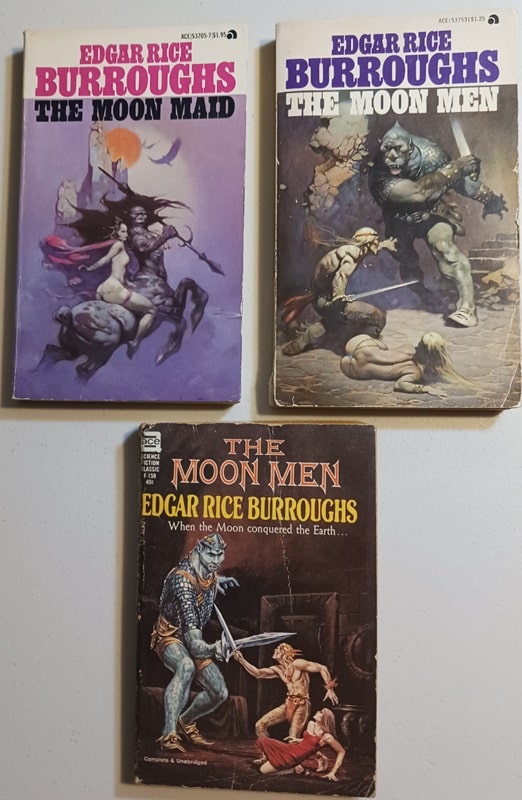 The Moon Maid, The Moon Men, and The Moon Men (Ace Books, January 1974, March 1974, and October 1962). Covers by Frank Frazetta, Frazetta, and Ed Emshwiller
The Moon Maid, The Moon Men, and The Moon Men (Ace Books, January 1974, March 1974, and October 1962). Covers by Frank Frazetta, Frazetta, and Ed Emshwiller
I enjoyed ERB’s Venus books a lot but they were not the equal of his Mars books — in my opinion. A lot of this has to do with Carson Napier. He’s no John Carter. He is a hero, and brave, but he makes plenty of mistakes and often needs to be rescued himself. He also uses more advanced weapons — essentially ray-guns — on many occasions. That means less “swashbuckling,” a minus for me. Certainly, though, if you’re interested in S&P fiction, the Venus books are a must.
The Venus books have been released in various editions. The pictures I have above mix older and newer editions. The older ERB books have covers and illustrations by Roy G. Krenkel, Jr, one of my favorite artists. Some of the newer ones have Frazetta images, and Frazetta was influenced by Krenkel.
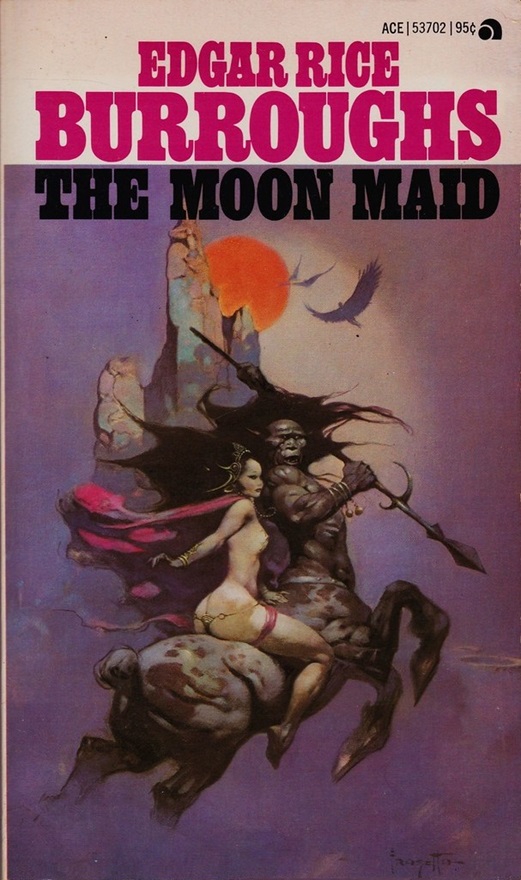 The Moon Maid (Ace Books, January 1974). Cover by Frank Frazetta
The Moon Maid (Ace Books, January 1974). Cover by Frank Frazetta
A series that I would have liked to see more of from ERB was his Moon Maid series. It’s sometimes described as a trilogy, but only the first book is full length. That’s The Moon Maid (copyright 1923). The sequels are novellas called The Moon Men and The Red Hawk (copyright 1925), which I first read combined in a later Ace book called The Moon Men. The novellas are reprinted from the pages of Argosy All-Story Weekly, where the tales were first serialized in 1925.
The Moon Maid has an awesome Frank Frazetta cover that is one of my favorites among his works. I have two copies of The Moon Men, one with a Frazetta cover and the other with a cover by Ed Emsh.
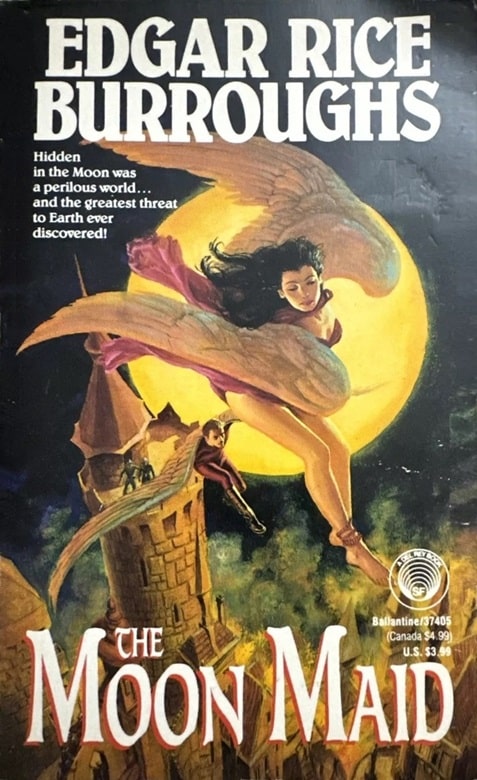
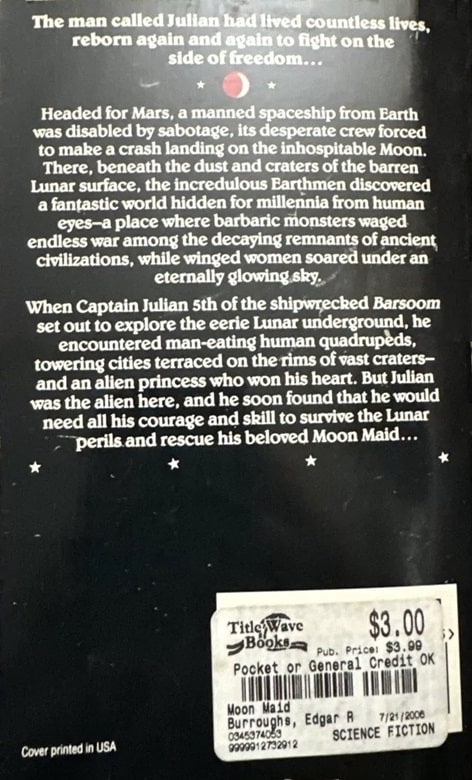
The Moon Maid (Del Rey Books, May 1992). Cover by Laurence Schwinger
The hero in The Moon Maid is Julian the 5th, an Earthman who has lived through many previous incarnations and remembers them. He is leading a rocket ship journey to Mars when the ship has to make a forced landing on the Moon.
They find an oxygen atmosphere inside the moon, and a wild land of strange creatures, including human-type and centaur-type intelligent races. Julian meets a princess of the human-type, Nah-ee-lah, and must rescue her. There’s lots of action and hand to hand combat, although not a lot of sword fighting. I would classify it as S&P.
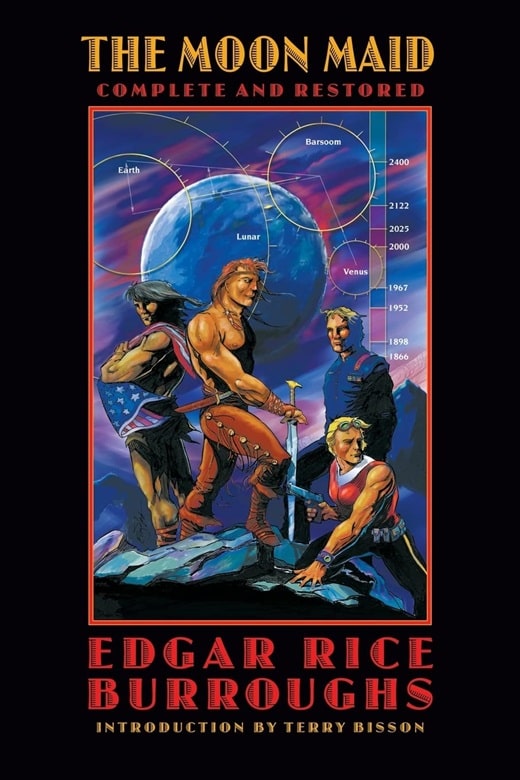
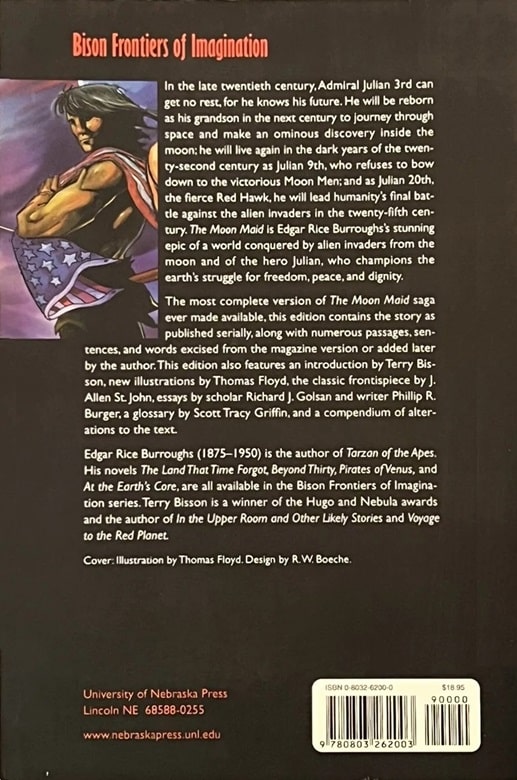
The Moon Maid: Complete and Restored (Bison Books, April 2002). Cover art by Thomas Floyd
The Moon Men and The Red Hawk are not — properly speaking — S&P fiction, because they take place on Earth. In The Moon Men, the Kalkar inhabitants of the Moon have conquered Earth. Julian the 9th, another reincarnation, leads a revolt, but it remains to “Red Hawk,” a descendent of Julian to finally free Earth from the Lunarians’ rule.
The three parts of the Moon trilogy have been published together by Bison books along with all kinds of extras (see above). I don’t have that copy yet but will get it for my collection. The series is one of ERB’s best.
More on Burroughs, including Tarzan and The Land that Time Forgot, in my next post.
Charles Gramlich administers The Swords & Planet League group on Facebook, where this post first appeared. His last article for Black Gate was The Masters of Narrative Drive.
Howard Andrew Jones, a Mentee’s Perspective
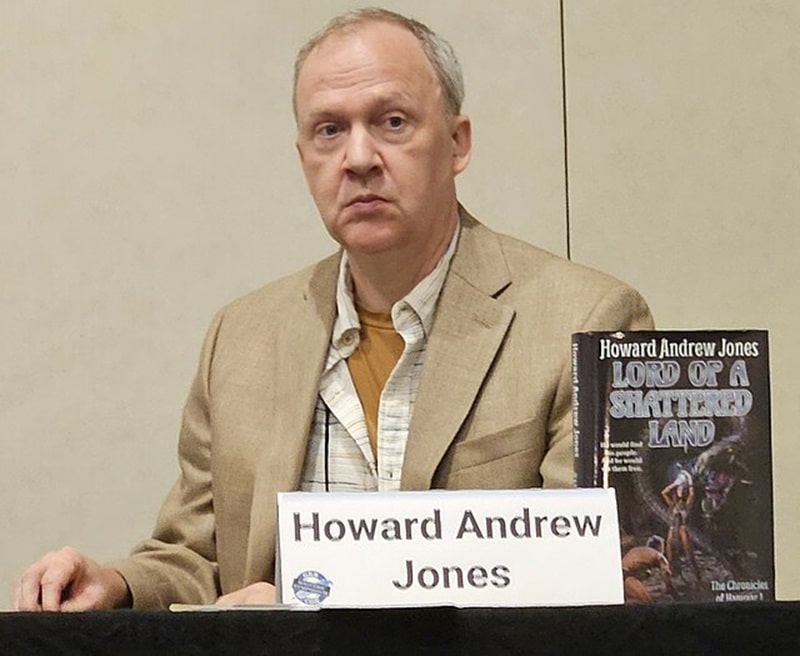 Howard Andrew Jones at GenCon, 2023
Howard Andrew Jones at GenCon, 2023
In 2019, I had an idea: a lot of my friends loved reading sword and sorcery fiction, but they didn’t write it. They would say, “One day.” Many of my undergraduates also expressed interest in writing fantasy, but they often felt discouraged by form rejection letters (genre magazine slush piles are epic). Having studied the history of genre fiction, I knew about the old tradition of “fanzines”— not-for-profit amateur publications that provided a low-stakes outlet for new writers. Just submitting work, collaborating with an editor, and seeing it in print can transform someone’s self-image from being just a reader to being a writer.
So, after some conversations with friends and a bit of encouragement, I started thinking seriously about launching my own zine.
As an academic, I’m deliberate by nature. I like to consult and take my time. Honestly, if I could have formed a committee for this, I probably would have. Instead, I decided to email someone: Howard Andrew Jones.
[Click the images for larger versions.]
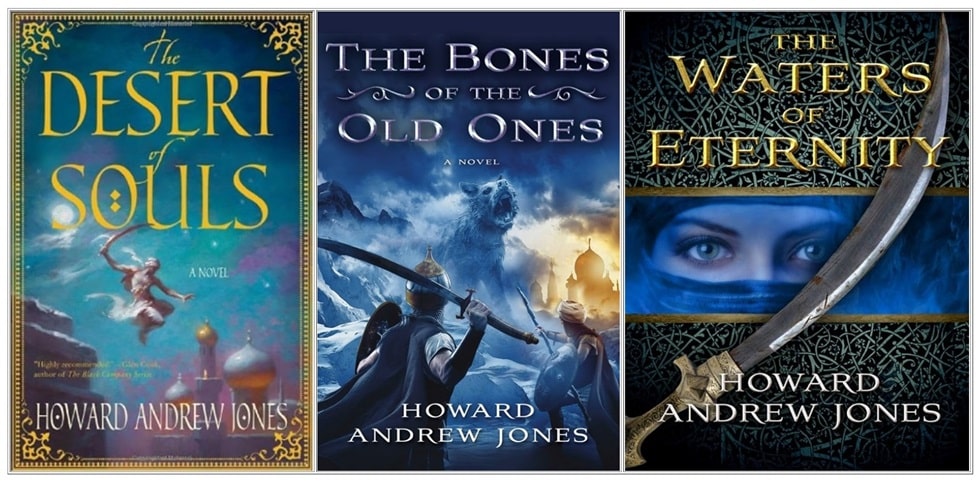 The three Dabir and Asim volumes: The Desert of Souls, The Bones of the Old Ones, and the collection The Waters of Eternity (Thomas Dunne Books, February 2011, December 2012, and November 2011). Covers by Charles Keegan, Steve Stone, uncredited
The three Dabir and Asim volumes: The Desert of Souls, The Bones of the Old Ones, and the collection The Waters of Eternity (Thomas Dunne Books, February 2011, December 2012, and November 2011). Covers by Charles Keegan, Steve Stone, uncredited
At the time, I didn’t know Howard personally, but I knew of him. He was a celebrated name in sword and sorcery. Howard had published an e-zine (Flashing Swords) in the genre, written essays and edited for Black Gate, and authored an incredible series of novels set in a sword-and-sorcery-inspired Arabia featuring Dabir and Asim (The Desert of Souls and The Bones of the Old Ones). He was also working on a new trilogy, The Ring-Sworn Trilogy, and I had already read the first book.
On top of all that, Howard had written several fun Pathfinder RPG novels, and he was editing Tales from the Magician’s Skull, the magazine for contemporary sword and sorcery fiction, published by Goodman Games. I loved that magazine. If anyone could give me advice on starting a zine, it was Howard.
I didn’t expect much when I emailed him. I wrote a long message, gushed a bit as a fanboy, and sent it off. Honestly, I wasn’t really expecting a response.
The next day, I was in my campus office grading papers when my office phone rang. My office phone never rings. In my ten years at CNU, maybe one student has ever called me. It’s practically an artifact – a dusty relic of a bygone era. My first instinct, as a millennial, was to let it go to voicemail. That’s what you do: let them leave a message and call back after some breathing exercises.
But for some reason, I picked it up.
“Hello?”
“Jason?”
“Yeah, this is Jason.”
The voice on the other end was calm, relaxed, with a kind of deliberate enunciation.
“Heeey, Jason! This is Howard.”
“Howard?” I said, not quite connecting the dots.
“Howard Andrew Jones. You emailed me about a magazine idea.”
I still get a little emotional thinking about that first call. Maybe I’m projecting, but I was immediately surprised, disarmed, and touched. Howard had gone out of his way to call me – call me! My office number isn’t even in my email signature, so he must have looked me up online to find my CNU contact info. I hadn’t even expected a reply, and here was this great author, taking the time to phone me.
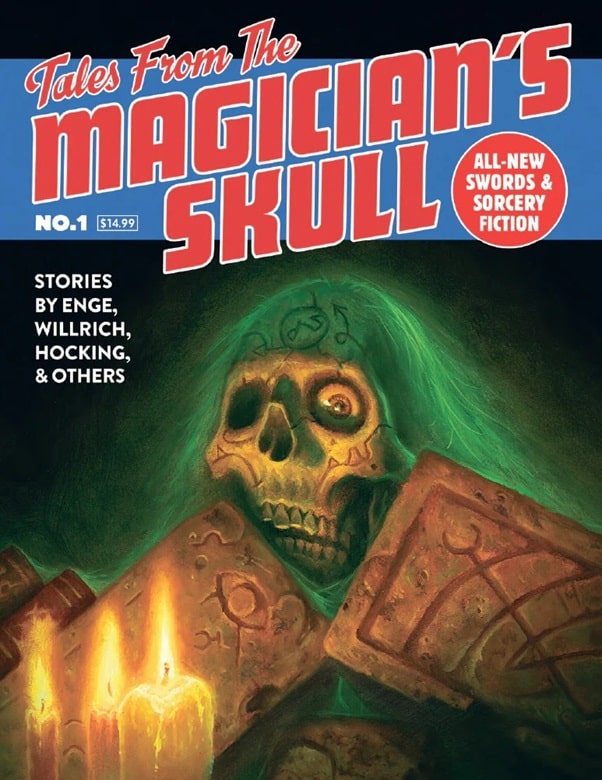
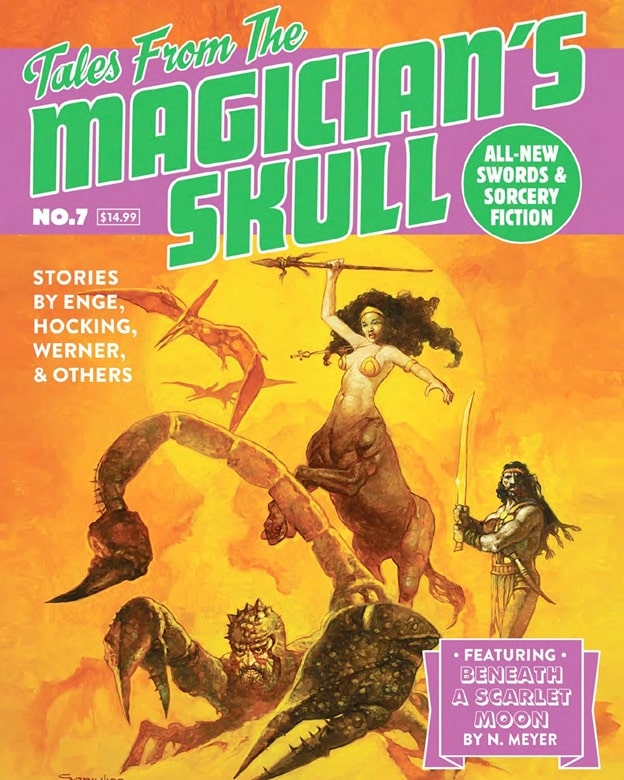
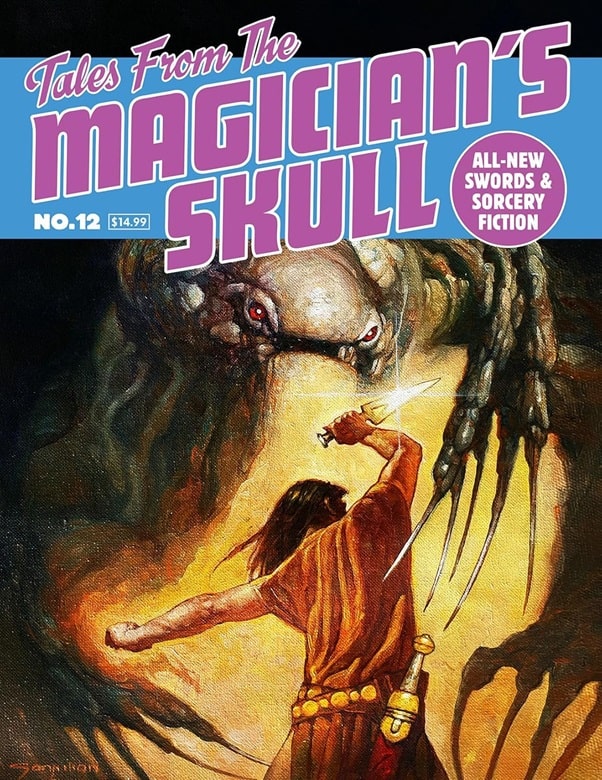
Tales of the Magician’s Skull, edited by Howard Andrew Jones. Issues 1, 7, and 12
(Goodman Games, 2017, 2022, and 2024). Cover art by Jim Pavelec and Sanjulian
I was a bit starstruck when we first talked. I’m already an awkward person, but the awkwardness was dialed up as I tried to gather my bearings. Howard, however, was so kind, calm, and genuinely enthusiastic about fiction, writing, and fantasy literature that I found myself speaking to him like an old friend. I’m pretty sure we talked for over an hour during that first conversation. I remember he was multitasking while on the phone – taking out the trash or doing yard work.
In the years that followed, whenever I spoke to Howard, he always seemed to be en route somewhere – driving to town, running errands, sometimes saying, “Hold on, I’ve got to grab this thing.” He felt real and grounded in a way that made people feel at ease. He gave off this sense of being completely unaware of how cool he was or how others saw him – or, if he did know, he just didn’t put much stock in it.
Over the next five years, Howard and I stayed in almost constant contact. We texted regularly. Often, he’d reply to a message with something like, “You free? Driving to town.” When I started my magazine and created an associated Discord server, he joined and became as active there as anyone, if not more so.
His comments were always supportive, kind, and encouraging. He shared favorite authors, thoughts on prose style, and a steady drip of wisdom for aspiring writers. Whenever anyone mentioned his work, he would chime in, “Thanks for reading it,” “Glad it worked for you,” “Really appreciate the kind words.”
Outside of Discord, we talked on the phone often. One thing I noticed was that Howard frequently mentioned his friends – not in a name-dropping way, like he wanted you to know he knew big authors, but in a way that made you feel like you were part of this collaborative effort, this network of fellow creatives. To him, it seemed, writing wasn’t a solitary pursuit but a shared craft. It was like Howard was always attending a seminar on fiction, and his calls were a way of touching base to see how your progress was going.
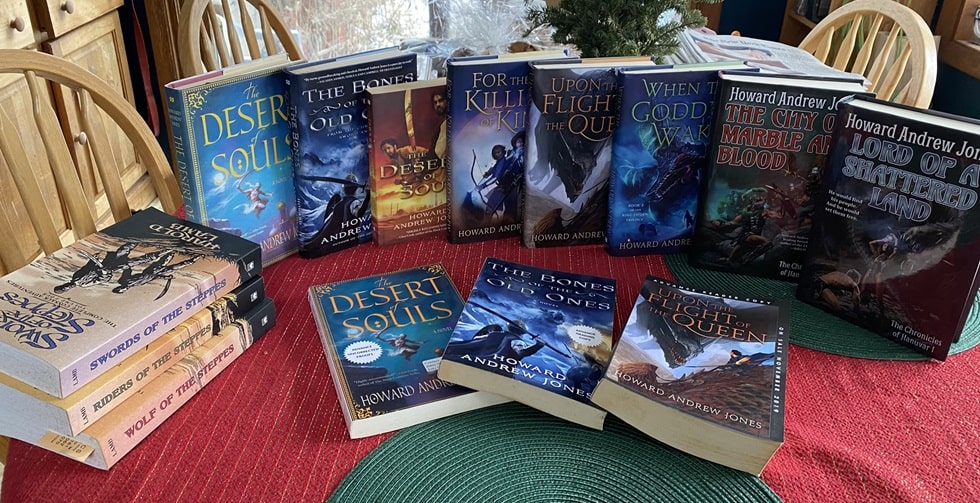 The books of Howard Andrew Jones
The books of Howard Andrew Jones
For instance, he’d say something like, “Hocking and I were talking about dialogue – how it needs to reveal character but economically, like in hardboiled detective fiction” (I’m paraphrasing). From the way he spoke, I got the sense that Howard had a lot of writer friends, and they talked about the craft of writing the way master carpenters might talk about solving technical problems with wood.
Fandom can get a little gossipy, but Howard never said a negative thing about anyone. He was almost stubbornly kind and assumed the best intentions from people. Being in touch with him felt like being welcomed into a very supportive club. Over time – without me even realizing it – Howard became something of a mentor or even a sensei in sword and sorcery writing.
At first, we just talked about sword and sorcery (a genre he was deeply opinionated about – he really didn’t like Tros of Samothrace (“Bounced right off it)), but our discussions evolved into broader topics: writing, work, heroism, and how storytelling affects people’s lives. I can honestly say I learned a lot about writing from him, at least an MFA’s worth, or more.
I met Howard in person three times over the six years I knew him. I saw him at GenCon, the big gaming convention that also includes a section for genre writers. We sat on several panels together discussing sword and sorcery fiction. He attended Howard Days, a celebration of Robert E. Howard, the pulp author who created sword and sorcery (yes, it gets confusing). And then I saw him again at GenCon this past August of 2024.
In August, aside from a persistent leg injury, Howard seemed… OK. I need to be honest and say he struck me as a little blue at GenCon, and he suspected it was due to the injury or the associated medication treating it. He had every reason to be happy. He had just published the first two books of his Hanuvar series. If I remember correctly, book three, Shadow of the Smoking Mountain, had just come out or was coming out. At the convention, he gave me an ARC and signed it with the words, “Find a way or make one.” I took this as a nod to the writer’s life, a reminder to persevere and create despite the challenges.
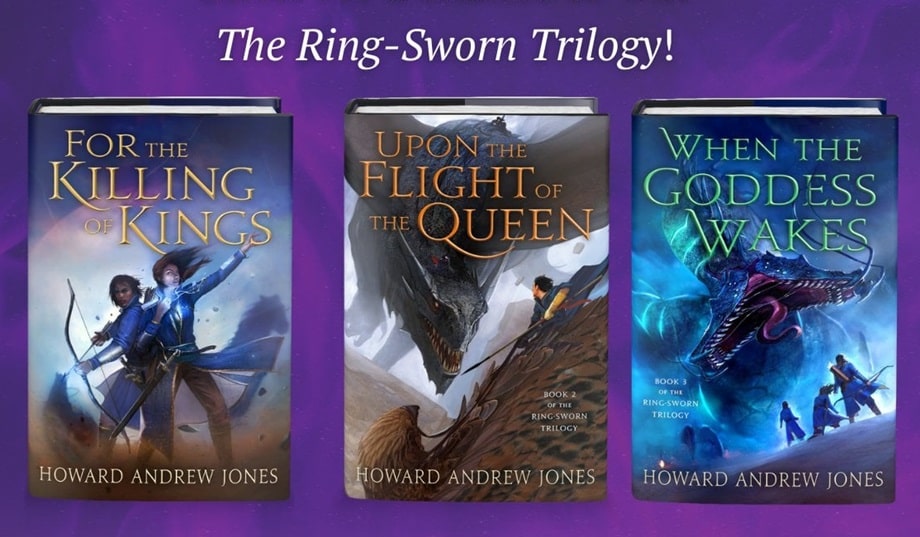 The Ring-Sworn Trilogy by Howard Andrew Jones (St. Martin’s Press, 2018-2021). Covers by Lauren Saint-Onge
The Ring-Sworn Trilogy by Howard Andrew Jones (St. Martin’s Press, 2018-2021). Covers by Lauren Saint-Onge
On the last day of GenCon, literally just before leaving, Howard, my wife Nicole, and I had lunch together. It was the first time Howard had met Nicole. She joked and referred to Howard as “my friend in my pocket” because I was always texting with him. I laughed and told her, “You don’t understand – this guy is so cool. He’s the nicest guy you’ll ever meet.”
That might sound like grief-motivated hyperbole now, but, in hindsight, it wasn’t. That’s exactly how I spoke about Howard before I knew anything was wrong.
Nicole and I had lunch with him, and of course, they hit it off. I can’t recall the details but Howard was fascinated with Nicole’s life growing up on a farm (did Howard come from a rural background?). After the meal, Howard said he was glad to have met her.
We left the restaurant. There were hundreds of people in the corridors at GenCon, a veritable sea of humanity, and Nicole and I were ready to leave, luggage in hand. So, we said our goodbyes. I had no idea it was the final goodbye. Howard gave me a hug and said, “Well, safe travels to you and your beautiful wife. And, keep writing.” Then he disappeared into the crowd.
A few weeks later, I learned he had gone to the hospital with acute symptoms.
I’m still in the anger phase of all this. Howard was such a good guy. It felt like, as a writer, he was hitting his peak. In my view, he had so much more to give the world – not just through his novels but through who he was as a person. I know my story is just one of many similar ones. That’s the kind of person Howard was: everyone who met him seemed to come away with a story about his kindness. This tragedy couldn’t have happened to a more undeserving person.
Howard, you’ll be missed, man. Thanks for being you.
Jason Ray Carney is a Lecturer in Popular Literature at Christopher Newport University. He is the author of the academic book, Weird Tales of Modernity (McFarland), and the fantasy anthology, Rakefire and Other Stories (Pulp Hero Press). He edited Savage Scrolls: Thrilling Tales of Sword and Sorcery for Pulp Hero Press and is an editor at The Dark Man: Journal of Robert E. Howard and Pulp Studies and Whetstone: Amateur Magazine of Sword and Sorcery. His last article for Black Gate was a review of Lord of a Shattered Land.
Savage Sword of Conan is Back
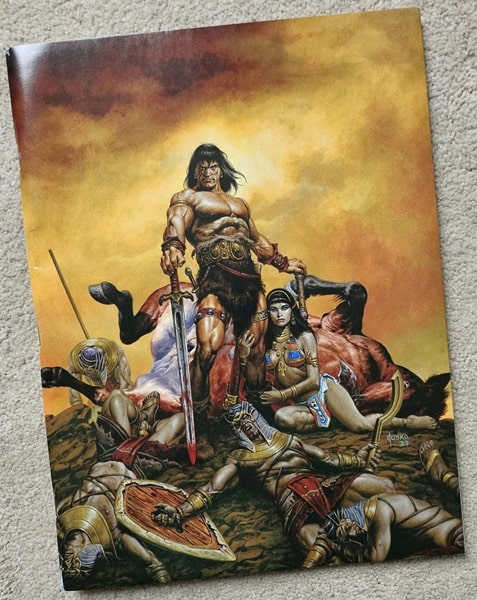
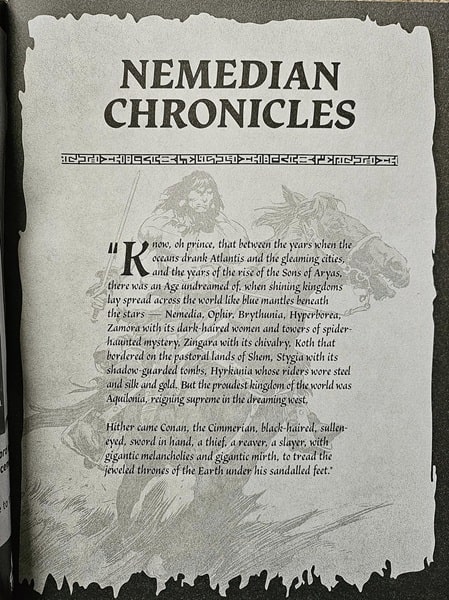
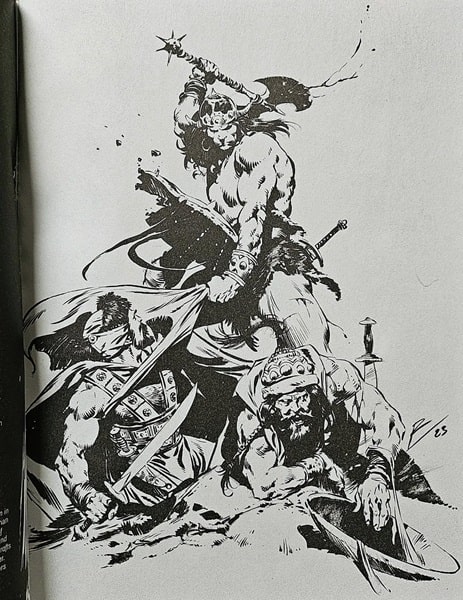
Savage Sword of Conan #1 (Titan Comics, February 2024). Cover art by Joe Jusko
Savage Sword of Conan, from Titan Comics, is the comic book that I have been waiting for. It is a thing of perfection: art, story, presentation, physical format – all unmatched.
The cover by Joe Jusko is brilliant, capturing some brutal imagery from the prose story within, penned by Jim Zub. I loved Joe’s work on the original SSoC run.
The introduction by Roy Thomas was a delight. Roy was the mastermind behind Conan the Barbarian and Savage Sword of Conan, but he’s also known for creating characters such as Wolverine, Vision, Werewolf by Night, Luke Cage, Iron Fist, Ultron, and scores more. Hearing that he had plans to contribute to this magazine filled me with joy.
[Click the images for savage-sized versions.]
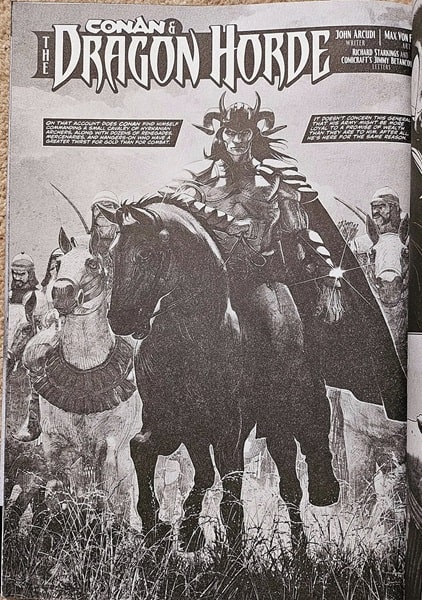
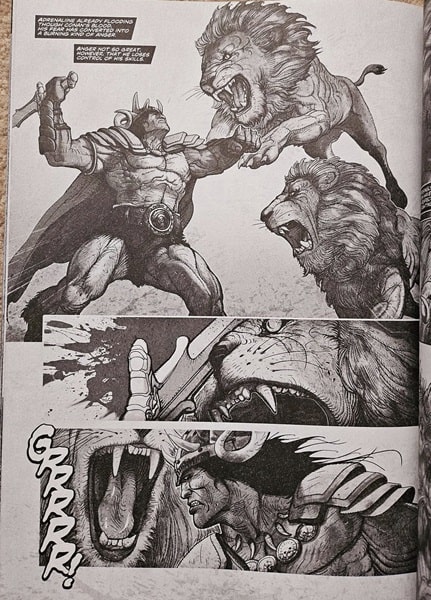
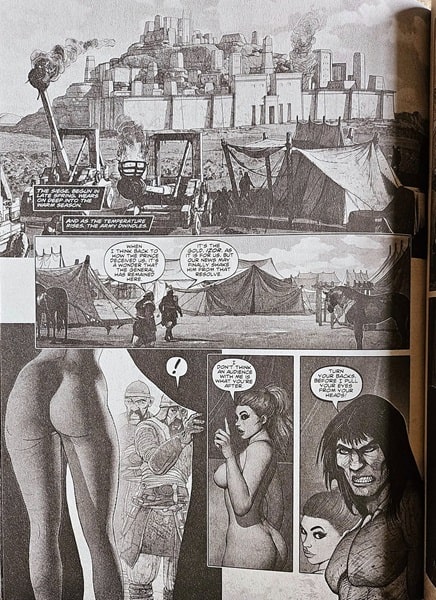
Interior pages from Savage Sword of Conan #1. Art by Max Von Fafner
The first story in SSoC #1 is called “Conan and the Dragon Horde,” written by John Arcudi, with art by Max Von Fafner. It has violence, bloodshed, nudity, sex, murder, betrayal, greed, superstition, intrigue, and horror. It is a classic Conan yarn that includes a fascinating female protagonist. Maybe she’ll stick around, or maybe she’ll go her own way, like Valeria. I can’t wait to see.
The prose story by Jim Zub, “Sacrifice in the Sand,” was a pleasant surprise. I have to admit to almost always feeling a sense of dread when someone other than REH writes Conan, but by Crom, this Zub guy gets it, much like his contemporary, John C. Hocking. The story was short, but the action was intense, realistic, and engaging, with a nice little twist at the end. Congrats, JZ.
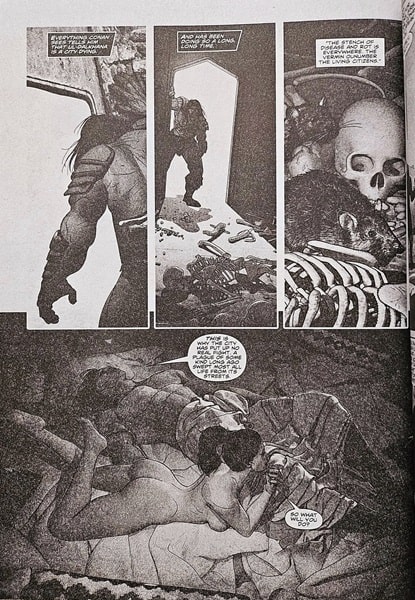
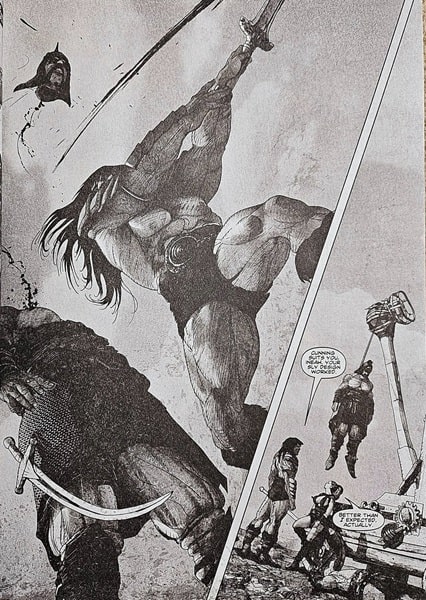
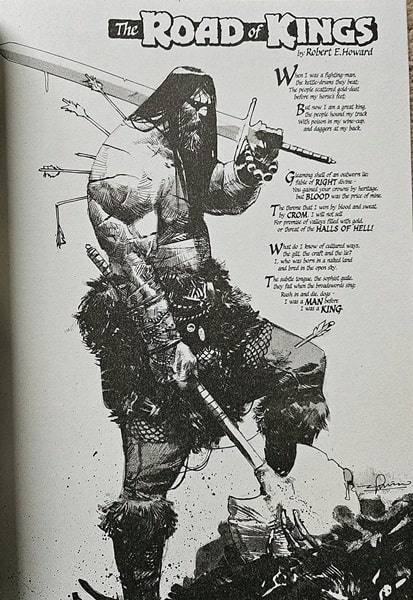
More interiors from Savage Sword of Conan #1. Art by Max Von Fafner
Next, we had a Solomon Kane yarn, “Master of the Hunt.” Placing an SK backup story in SSoC is chef’s kiss perfect. It brings back wonderful memories. Written and illustrated by Patrick Zircher, this was an excellent Gothic tale, with all that 1600s mood and tone. The Puritan gun-toting swashbuckler is one of REH’s finest creations, and he is well represented here.
The magazine closes with a piece by Jeffrey Shanks, who delves into the publishing history of Solomon Kane, which many readers will no doubt find fascinating. Jeff is a bona-fide REH scholar, much like my dog brothers, Mark Finn and Chris Gruber.
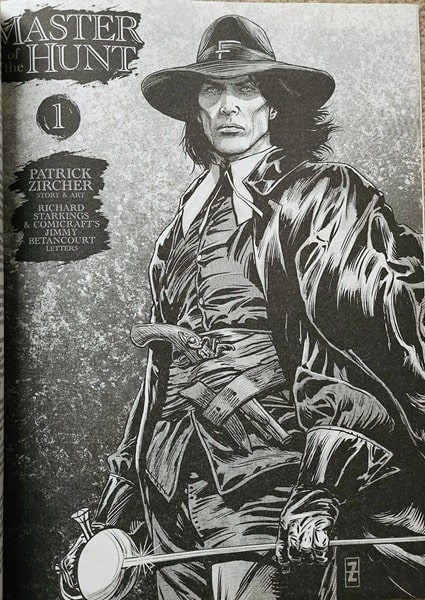
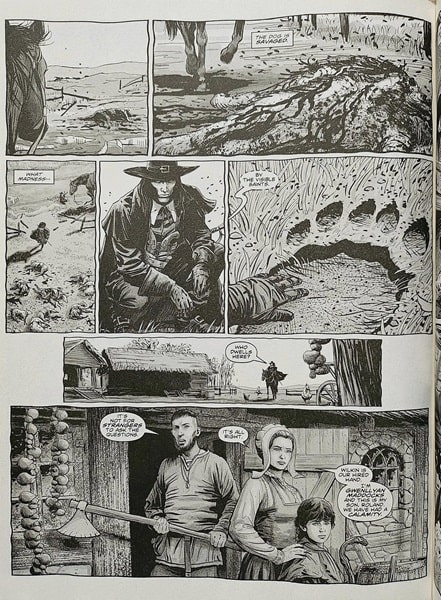
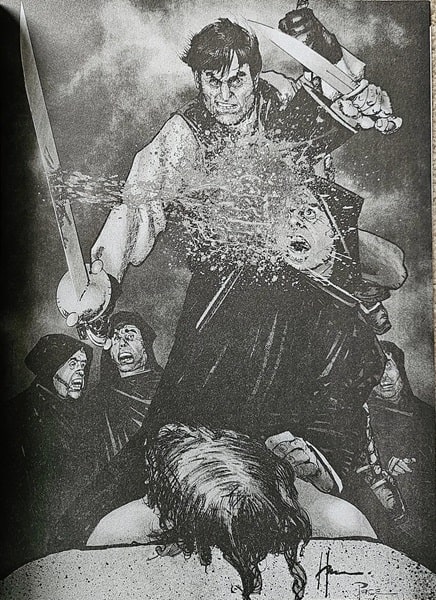
Interiors from Savage Sword of Conan #1. Art by Patrick Zircher and Howard Chaykin
This book was great. The husky offset paper is thick and opaque, yet has that newspaper quality to it, bringing back the nostalgia of the original run. You can smell the ink – it’s glorious.
One thing I would love to see in the future (and I know this is wishful thinking) is art by Val Semeiks in the pages of this series. I’ve been working with Val off and on for eight years on Hyperborea RPG content, and I think it would be a wonderful “full circle” event to see him back where he started – illustrating Kull in SSoC. I’d love to see that happen.
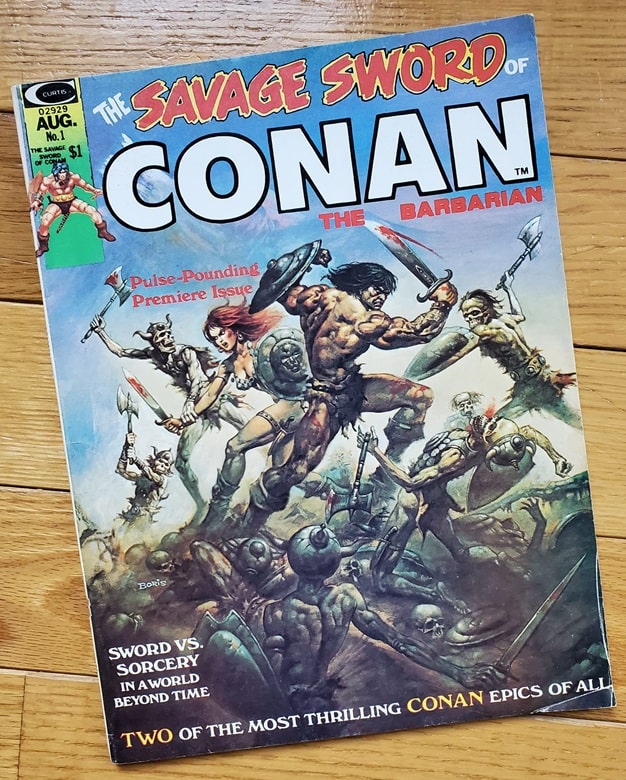
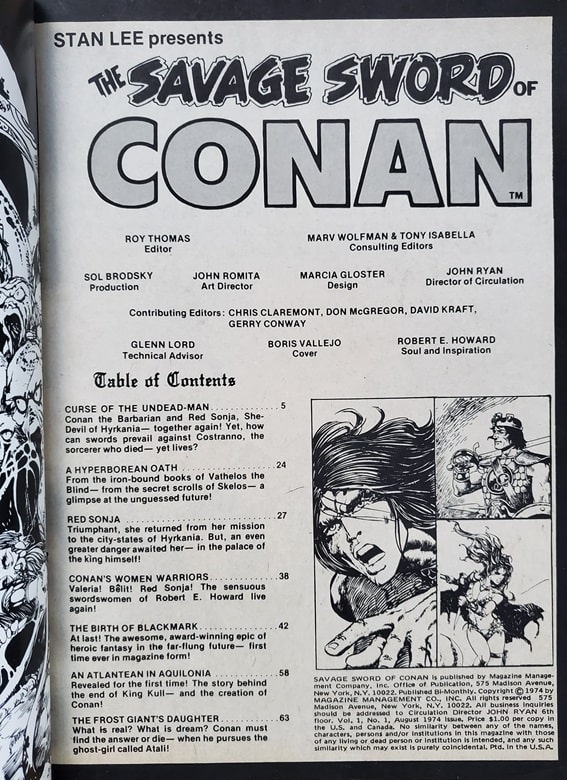
Savage Sword of Conan #1 (Marvel Comics, 1974). Cover by Boris Vallejo
The original Savage Sword of Conan #1 was published in 1974, featuring an incredible cover painting by Boris Vallejo (see above). It picked up where Savage Tales had left off, with Roy Thomas spearheading the efforts within.
The talent of the contributors is off the charts: John Buscema, Barry Smith, Alfredo Alcala, Gil Kane, Pablo Marcos, Esteban Maroto, Neal Adams, Ernie Chan, and a riveting article by Glenn Lord. All of it, as Roy Thomas states “… is dedicated to Conan and the other heroic-fantasy creations of the late Robert E. Howard (1906-1936).”
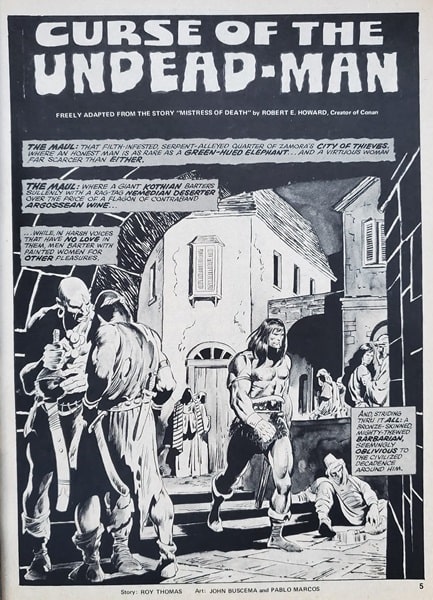
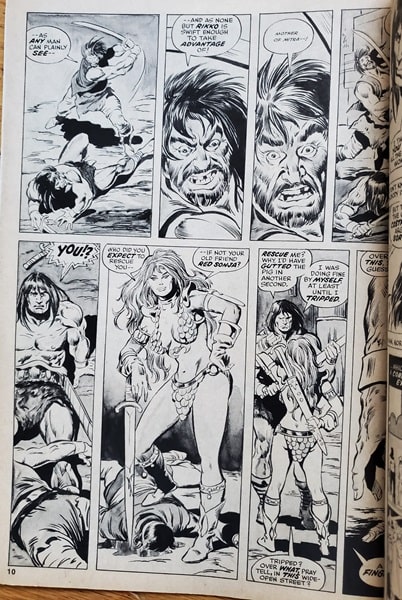
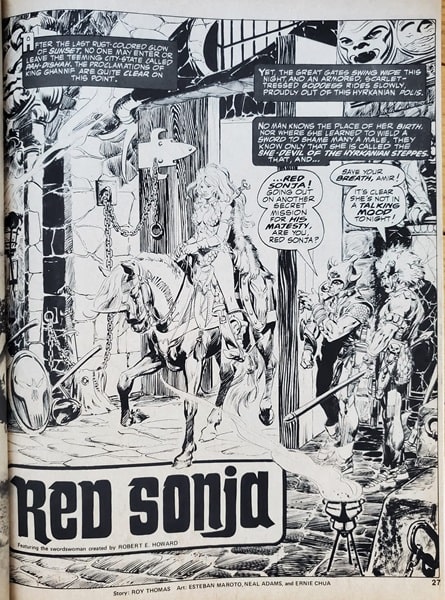
Interiors from Savage Sword of Conan #1 (Marvel Comics, 1974). Art by
John Buscema, Pablo Marcos, Esteban Maroto, Neal Adams, and John Chua
I already had a copy of this book, but I picked up this backup copy for $20 from my old pal, Chris, of Chris’s Comics.
For me, the most iconic Conan art was established by Frank Frazetta with his cover paintings on the Lancer paperbacks, and John Buscema with his cover and interior art in Marvel’s Conan the Barbarian and Savage Sword of Conan. When I was young, one of the things I always looked forward to was the next issue’s cover painting for SSoC.
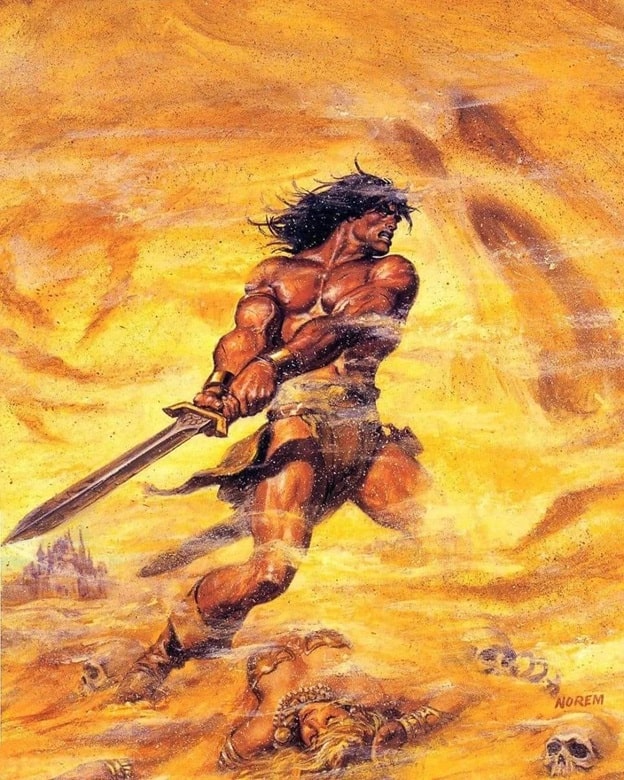 Cover art for The Savage Sword of Conan #54 (Marvel Comics, July 1980). Art by Earl Norem
Cover art for The Savage Sword of Conan #54 (Marvel Comics, July 1980). Art by Earl Norem
They rarely disappointed. Among those cover painting artists, one of my personal favorites was Earl Norem. I don’t believe he has received the attention he deserves for capturing incredibly dynamic scenes, such as the one pictured above, fighting a sand demon.
One of the prizes of my personal collection is the page below, purchased at a NY Comicon in the late 90s. This is an original page from Savage Sword of Conan #197, published in May, 1992.
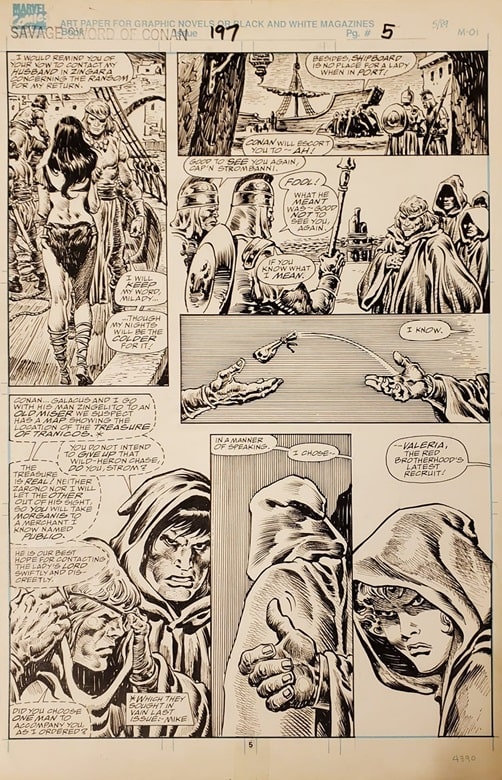 Original art from Savage Sword of Conan (Marvel Comics, May, 1992). Art by John Buscema and Ernie Chan
Original art from Savage Sword of Conan (Marvel Comics, May, 1992). Art by John Buscema and Ernie Chan
It features Roy Thomas writing, John Buscema pencils, and Ernie Chan inks. The ultimate creative dream team. On this page we see Conan, Belit, and Valeria. This is a one-of-a-kind piece that I will never part with!
One of the ultimate dream teams in comic book history was Roy Thomas, John Buscema, and Alfredo Alcala. The page below is from Savage Sword of Conan #20, adapting the Robert E. Howard story “The Slithering Shadow,” originally published in Weird Tales magazine in 1933. A sword-and-sorcery masterpiece.
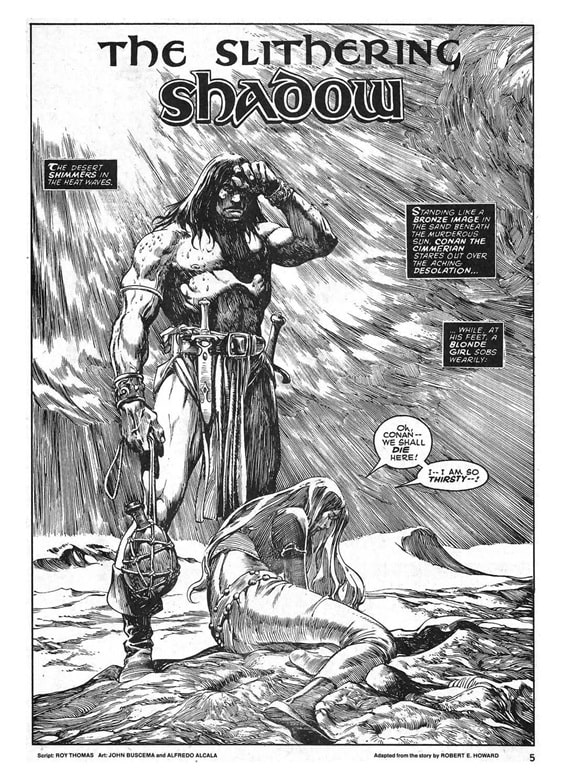 Splash page from Savage Sword of Conan #20, by Roy Thomas, John Buscema, and Alfredo Alcala (Marvel Comics, July, 1977)
Splash page from Savage Sword of Conan #20, by Roy Thomas, John Buscema, and Alfredo Alcala (Marvel Comics, July, 1977)
The third and final volume of Barbarian Life: A Literary Biography of Conan the Barbarian, by Roy Thomas, is a must-have for fans of Roy’s take on Robert E. Howard’s most famous character.
In thousands of four-color panels for Marvel Comics, Roy Thomas told the tale of Robert E. Howard’s greatest creation, Conan the Barbarian. Now, in this definitive biography and analysis, Roy chronicles Conan’s comic book life, issue by issue, plot by plot, and artist by artist.
For ten years, from October 1970 when Roy and artist Barry Smith assembled the first issue of Marvel’s Conan the Barbarian, to October 1980 when Roy and artist John Buscema completed their last issue together on the series, Thomas wrote of Conan’s gigantic melancholies and gigantic mirth — as well as the wars, the wenches, and the wizardry that bedeviled the Cimmerian from one issue to the next.
In this final volume of the series, Roy Thomas explains the creative process behind his final few issues of Conan the Barbarian, his run on King Conan, and selected stories published in Savage Sword of Conan. Additional features include a full-length interview with Roy, a short history of sword-and-sorcery in the comics, and the tale of Conan’s battles with the Comics Code.
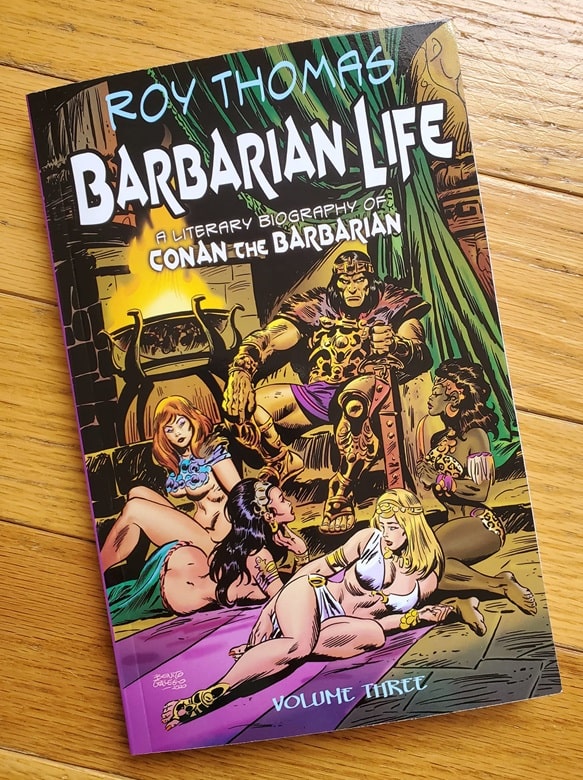 Barbarian Life: Volume Three: A Literary Biography of Conan the Barbarian by Roy Thomas (Pulp Hero Press, April 26, 2021)
Barbarian Life: Volume Three: A Literary Biography of Conan the Barbarian by Roy Thomas (Pulp Hero Press, April 26, 2021)
Now, I do want to preface what I am about to say by noting that my thoughts may be clouded by the nostalgia of my youth: lying on my bedroom floor, poring over my Conan comics and studying the words and art with rapt interest.
That being said, of all the pastiche authors who have developed new, original Conan tales, Roy Thomas may be my favorite — and he did it with the accompaniment of a brilliant visual medium, working with some of the finest artists of the day, such as the aforementioned Barry Smith and John Buscema, and also greats such as Alfredo Alcala, Gil Kane, and Ernie Chan.
Unfortunately, one of my favorite Conan artists, the incredible Val Semeiks, didn’t cross paths with Roy, but he deserves mentioning nonetheless for his breathtaking art.
Jeffrey P. Talanian’s last article for Black Gate was The Dreams in Gary’s Basement: Gary Gygax and the Creation of Dungeons & Dragons. He is the creator and publisher of the Hyperborea sword-and-sorcery and weird science-fantasy RPG from North Wind Adventures. He was the co-author, with E. Gary Gygax, of the Castle Zagyg releases, including several Yggsburgh city supplements, Castle Zagyg: The East Mark Gazetteer, and Castle Zagyg: The Upper Works. Read Gabe Gybing’s interview with Jeffrey here, and follow his latest projects on Facebook and at www.hyperborea.tv.
An Important Life – Howard Andrew Jones (1968 – 2025)
A LIFE IS NOT IMPORTANT EXCEPT IN THE IMPACT IT HAS ON OTHER LIVES – Jackie Robinson’s epitaph
 Mark Rigney, Howard Andrew Jones, Bob Byrne
Mark Rigney, Howard Andrew Jones, Bob Byrne
I did an interview last week with Jason Waltz for his ’24 in 42′ podcast (Yeah, I know: You just can’t wait to hear that one…).
One of the questions was about my favorite quote/lyric/poem/motivational thought. Some of you who know me probably figure it’s a Bible verse. And there are a couple that are right up there.
But it’s the epitaph on Jackie Robinson’s gravestone, which leads off this post.
My buddy Howard Andrew Jones has passed away from brain cancer. You’re going to see a LOT of people singing his praises in the coming weeks. All of it deserved. If I can stop crying long enough, my Monday morning post will be on Howard.
But you’re gonna see a common thread in the talk about Howard. The impact he had on other people’s lives. Especially in encouraging and helping writers – mostly in the sword and sorcery field.
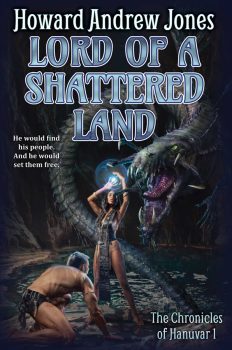 Measured by impact, Howard’s may well be the most important life in the past three-plus decades in the genre. He was relentless in being kind, helpful, encouraging, engaging – just fucking NICE – in an era when nice isn’t all that common anymore.
Measured by impact, Howard’s may well be the most important life in the past three-plus decades in the genre. He was relentless in being kind, helpful, encouraging, engaging – just fucking NICE – in an era when nice isn’t all that common anymore.
My favorite memories of Howard are our phone talks about hardboiled private eye fiction: not what you’d guess of one of the brightest lights in the sword and sorcery genre.
But as you read the posts about Howard here on FB, just keep noting how many people thank him for helping them. For impacting their lives and careers.
Howard totally lived that quote on Robinson’s headstone. More than most of us do. A good man who lived an important life.
The world’s light is a little less bright this wintry day. A star has gone out.
That was my response to seeing John O’Neill’s post on Friday, announcing that Howard had lost his battle with brain cancer. Facebook has been full of fond memories and sorrows from his many friends.
There are two people I’ve gotten to know somewhat through my writing/blogging, who were liked by everyone who knew them. No one had a bad word for mystery writer Bill Crider, or for Howard. He did not suffer bullshit well, but if you knew him, you were his friend. And you felt fortunate to be one.
I only met him once, at a Windy City Pulp Fest, but we talked on the phone, emailed, and FB messaged. I always enjoyed talking to him. We often compared the aches and pains of trying to remain physically active as we grew older. And suddenly, he won’t grow any older. Life can suck.
Regarding his work, my favorites are his Dabir and Asim Arabian stories. The two novels are epic Arabian fantasies – ‘swords and sandals’. But the short stories are really mysteries in an Arabian fantasy setting, and I love that! If you don’t at least have Waters of Eternity in digital, you totally should.
I liked his Pathfinder novels. The Ring-Sworn trilogy was good, but not one of my favorites.
I had not yet started his most recent trilogy, The Chronicles of Hanuvar, though I had read a couple short stories, which he incorporated into the first novel, ala Raymond Chandler (Howard was a hardboiled PI Pulp expert). I sat down Friday night, and I spent a chunk of my weekend working through Lord of A Shattered Land.
This is Howard’s best work. He had moved to another level. I assume books two and three will only drive that home. He had signed a five-book deal with Baen. They liked it so much, they added two more books to his contract.
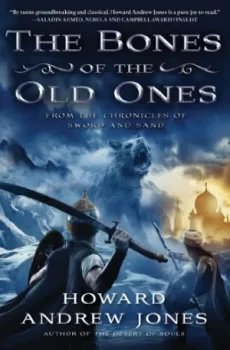 Howard was a year younger than me, and he had a lot of great writing years ahead of him. He was taken far too soon – I feel the same about Carl Wilson of the Beach Boys.
Howard was a year younger than me, and he had a lot of great writing years ahead of him. He was taken far too soon – I feel the same about Carl Wilson of the Beach Boys.
As I said in my FB post, Howard was nice. He was a genuinely good guy. He was fun to talk to, and he really was committed to helping people in the field. If you saw his FB updates on the chicks (he operated a farm) in winter, you got a sense of what a neat guy he was.
I got to visit him once after the news of his illness came out. That’s the pic above, with three of us Black Gaters together. He was still the gentle, soft-spoken soul I knew.
I hope the plaudits and the accolades keep coming. And I hope there’s something in his memory at 2025 Windy City.
Howard will be missed by many, for many years to come. The following is from his first Hanuvar novel, and it’s become the Howard quote for many of us, with his passing:
“Why are you crying? Warrior’s don’t cry.”
“They do when a hero dies.”
We lost a hero. I’m one of many who will miss you greatly, friend.
And if you’re looking for some modern fantasy to read, you really ought to grab that first book and check out one of the finest sword and sorcery writers of this century:
The Chronicles of HanuvarLord of a Shattered Land
The City of Marble and Blood
Shadow of the Smoking Mountain

Bob Byrne’s ‘A (Black) Gat in the Hand’ made its Black Gate debut in 2018 and has returned every summer since.
His ‘The Public Life of Sherlock Holmes’ column ran every Monday morning at Black Gate from March, 2014 through March, 2017. And he irregularly posts on Rex Stout’s gargantuan detective in ‘Nero Wolfe’s Brownstone.’ He is a member of the Praed Street Irregulars, founded www.SolarPons.com (the only website dedicated to the ‘Sherlock Holmes of Praed Street’).
He organized Black Gate’s award-nominated ‘Discovering Robert E. Howard’ series, as well as the award-winning ‘Hither Came Conan’ series. Which is now part of THE Definitive guide to Conan. He also organized 2023’s ‘Talking Tolkien.’
He has contributed stories to The MX Book of New Sherlock Holmes Stories — Parts III, IV, V, VI, XXI, and XXXIII.
He has written introductions for Steeger Books, and appeared in several magazines, including Black Mask, Sherlock Holmes Mystery Magazine, The Strand Magazine, and Sherlock Magazine.
In Dreams: David Lynch: 1946 — 2025
David Lynch is gone; he died Wednesday at the age of seventy-eight, bringing one of the strangest careers in American film to an end and leaving the rest of us to try to reach a conclusion as to what it all meant.
He never made a western. He never made a romcom or a workplace comedy. He never made a “prestige” period picture. He never made a buddy movie or an action movie or a heist movie or a (straightforward) crime movie. Not for him was getting hold of a franchise and riding it until it died of thirst in the desert; he wasn’t interested in making Mission Impossible 6 and 7/8. The only things he made were David Lynch movies (as the producers of Dune found to their dismay), and those were about as far out of the mainstream of American cinematic entertainment as it is possible to get and still be permitted within the city limits of Hollywood.
I resist calling him an “experimental filmmaker” — though there is a grain of truth in the description (in the effect of his work more than in its intent) — because I don’t think he was experimenting at all; I think he had a cement-solid vision of what film was and what it could do, and he knew precisely what he was up to every single minute.
For much of the past fifty years, people have spent countless hours burning up mental calories trying to “figure out” Eraserhead, Mulholland Drive, Fire Walk with Me, and Lost Highway, which seems to me to be a waste of time (though there are worse things to do with your idle hours). David Lynch’s films aren’t Sudokus, nor are they housing tract prospectuses or blueprints for can openers or toaster ovens; they’re dreams, and if his career illustrates anything, it’s how literal and flatfooted the vast majority of films are, and how very few filmmakers utilize to any degree the extraordinary power of the medium to dissolve and reconfigure the walls of reality. (In this a goof like Ed Wood beats most of today’s A-List directors, though Wood’s surrealism was the result of ineptness rather than art.)
Lynch’s most puzzling visions stubbornly resist dissection or definitive explanation, but most of the difficulty results from seeing them as puzzles in the first place. Instead, they’re spiritual weather reports; David Lynch was a meteorologist of the soul, and though he was American to the core, his movies have more in common with European films like Alain Resnais’ Last Year at Marienbad or Ingemar Bergman’s Persona or Hour of the Wolf than they do with the more commercial work of his American contemporaries.
The first Lynch film I saw was The Elephant Man (1980), which was (along with 1999’s The Straight Story) as “normal” a movie as he ever made. Even then, though, I knew that this was about as far from being a conventional, heartwarming, “disease-of-the-week” weepie as you could get. The difference becomes clear when you compare the film to the box-office winners of 1980 and imagine how the directors of The Empire Strikes Back, Private Benjamin, 9 to 5, or Coal Miner’s Daughter would have handled the story of John Merrick.
Not everyone responded positively to Lynch’s oblique, uncompromisingly interior approach, especially at first. It royally ticked off Roger Ebert, for instance, who was presumably upset that The Elephant Man wasn’t the sort of thing Sydney Pollack would have given us. Ebert also hated Wild at Heart (1990), Lynch’s off-kilter, violent, Wizard of Oz-inflected love story, though how the man who wrote Beyond the Valley of the Dolls could disdain “sophomoric humor” or criticize anyone for indulging in the “cop-out” of “pop satire” is beyond me.
As time went by, though, Lynch gathered more and more approval, but many critics praised him because of the attack they believed he was mounting on the values of what used to be called “Middle America.” What else could a movie like Blue Velvet be but a savage repudiation, an unqualified exposure of the wormy rot underneath the shiny linoleum?
However, in seeing Lynch as an unqualified celebrator of subversion, these critics were missing half the boat. Lynch didn’t believe that the “real truth” of the world was a hidden corruption that was bound to come out sooner or later and overwhelm everything, or that the scrubbed, brightly-polished surface of “normality” was nothing but a lie or a hypocritical sham.
He believed in the reality and power of both the decency and the corruption. You cannot accuse David Lynch of cynicism (Ebert’s mistake), but he was certainly as Manichean as they come, seeing as he did a world poised on the razor’s-edge between darkness and light, with each constantly trying to encroach on the other’s domain. It’s his acknowledgement of both aspects of life and his rapt love of their battle, and his belief that the balance between them is subject to the merest breath, that make him such a complex — and divisive — artist.
Certainly, a man who could make both Blue Velvet, in which the placid surfaces of ordinary life conceal a subterranean hell of twisted desire and violence, and The Straight Story, where the only perversion is the decision to ride a lawn mower across the state to visit an estranged brother, is a one-of-a-kind visionary. Those two films may be Lynch’s most emblematic ones, and they are not opposites, as may appear at first glance; they are fraternal twins, one light, one dark, but standing shoulder-to-shoulder and hand-in-hand. That they both issued from the same mind and are the products of the same sensibility may be the most disturbing thing of all — they are, in fact, both the work of an Eagle Scout.
He is irreplaceable. We have other great directors — Paul Thomas Anderson, David Fincher, Kathryn Bigelow, Martin Scorsese, Quentin Tarantino, to name just a few. But even the most adventuresome of them rarely do more than occasionally edge a toe into the territory that David Lynch spent his whole career traversing from corner to corner. He was fearlessly committed to going ever farther, digging ever deeper. He was like a legendary explorer, again and again plunging into trackless, unknown territory where anything might happen. Every film was a Lewis and Clark expedition into the wild unconscious, and the reports he brought back from those brave forays into the void revealed unbelievable terrors and awe-inspiring beauties.
Probably like many others, when I heard of Lynch’s death the first film I though of was Eraserhead. Back in the Pleistocene (the early 1980’s, that is), if you heard about an interesting movie and wanted to see it, you pretty much had only one recourse — your local video store, and so I rented a VHS cassette of Eraserhead from the Blockbuster down the street. Then, late one night, while my wife slept peacefully in our bedroom, I turned off the lights in my living room, put the movie in the player, and was instantly plunged into an eerie, repulsive, frightening, baffling, disorienting world that was also undeniably comic and even, at times, darkly beautiful. I was clearly watching something that was not made for me — or against me, for that matter. It wasn’t made with reference to me at all, or to anyone or anything else in the world. It was wholly itself, and came to me like an artifact from another universe.
No movie has ever given me the creeps like Eraserhead did — or made me think like it did. When it was over, I sat alone in the darkness and wondered what the hell had just happened.
Old movie posters often used to be emblazoned with a cheesy boast — “Like Nothing You’ve Ever Seen Before!!” The silly slogan came true in Eraserhead; it came true again and again in everything that the enormously gifted, magnificently weird, profoundly divided David Lynch gave us. I’m sorry that he is gone, but I’m so grateful that he was here. There was only one of him, and considering the disquieting nature of his unique vision, I’m glad for that, too. I can only take so many nights like the one when I watched Eraserhead.
Thomas Parker is a native Southern Californian and a lifelong science fiction, fantasy, and mystery fan. When not corrupting the next generation as a fourth grade teacher, he collects Roger Corman movies, Silver Age comic books, Ace doubles, and despairing looks from his wife. His last article for us was A Singular Success: Fat City
Prehistrionics, Part III
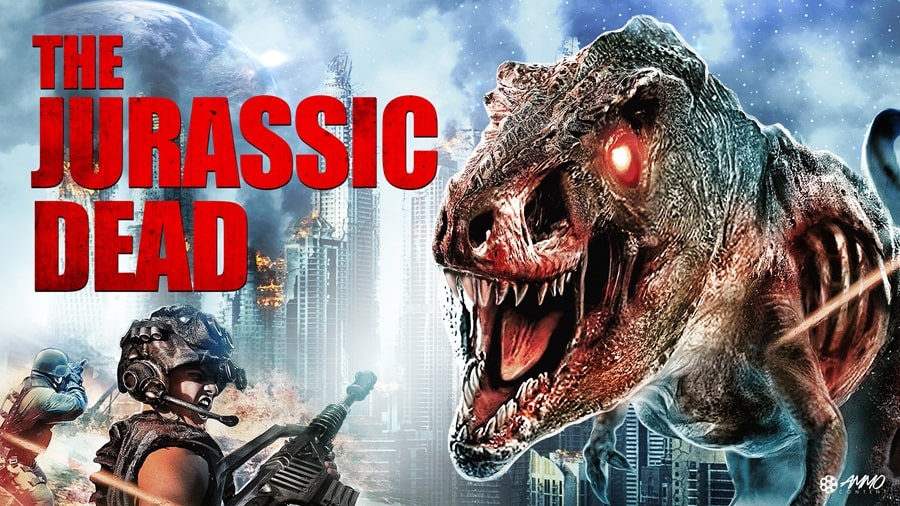 The Jurassic Dead (Wild Eye Releasing, 2017)
The Jurassic Dead (Wild Eye Releasing, 2017)
We’re off on another adventure filled to the brim with disappointment. 20 films I’ve never seen before, all free to stream, all dinosaur-based.
Oh God.
The Jurassic Dead (2017) TubiJust how bad is the CG? Rubbish.
Sexy scientist? Nope.
Mumbo jumbo? Reanimation, dinosaurs, zombies, asteroids.
Just in case you thought I might try to start the year on a high note, might I present this tripe. The premise is simple: a Herbert West type (complete with glowing green reanimating fluid and dead cat) loses his job and decides to destroy the world. Somehow he has a T-Rex, which he zombifies, and then he turns into Immortan Joe and sets off an EMP just as asteroids wipe out some cities. A crack, sorry crap, team of commandos based on 80s action figures must team up with a group of hugely unlikeable civilians to survive.
Everything ends in nuclear devastation. Effects-wise, the dinosaur is a cute, Walking with Dinosaurs puppet, but everything else is shockingly awful green screen composites. Just terrible.
3/10
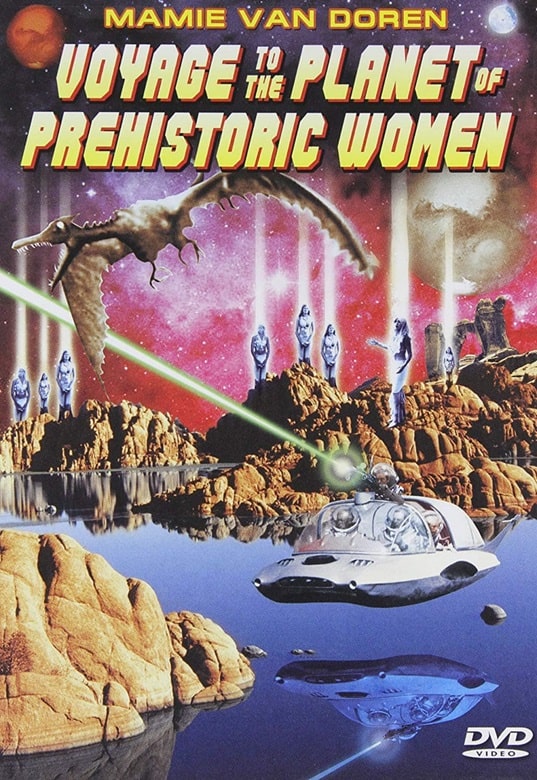
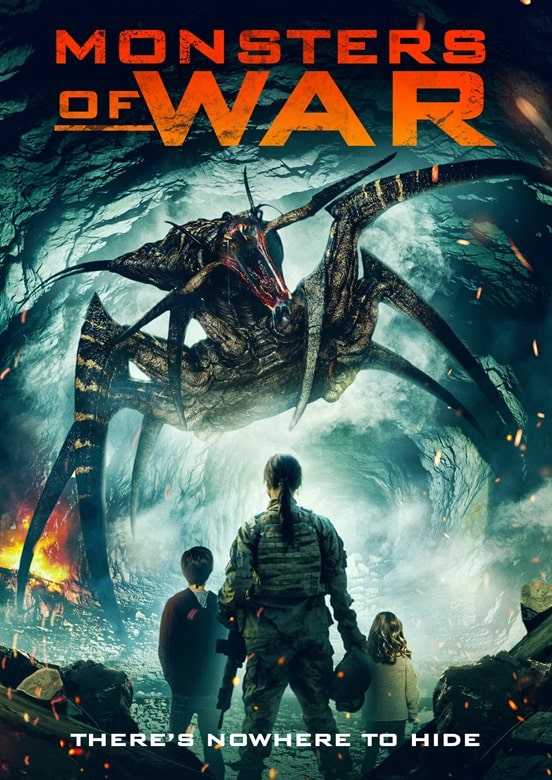
Voyage to the Planet of Prehistoric Women (AIP-TV, 1968), and Monsters of War (Jagged Edge Productions, 2021)
Just how bad is the CG? There is none.
Sexy scientist? Nope.
Mumbo jumbo? Venus, dinosaurs, telepathy
There’s a Russian sci-fi movie called Planeta Bur that got cannibalized twice by AIP under the eye of Roger Corman. One version was Voyage to the Prehistoric Planet, which I have seen, and the other is this one, identical except for 10 minutes of footage of blond ladies telepathically moaning about their dead pterodactyl.
This was made by Peter Bogdanovich and, a day after his death, I’ll let him explain:
Planeta Bur was a Russian science-fiction film that Roger had called Storm Clouds of Venus that he had dubbed into English. And he came to me and said, “Would you shoot some footage with some women? AIP won’t buy it unless we stick some women in it.” So I figured out a way to work some women in it and shot for five days, and we cut it in. I narrated it, because nobody could make heads or tails of it. Roger wouldn’t let me add any sound. It was just a little cheap thing we did, and people think I directed it when I really only directed 10 minutes of it.
It’s barking mad, best watched stoned, and strangely charming.
I was actually watching Voyage to the Planet of Prehistoric Women as part of the Prehistrionics project when I heard Peter Bogdanovich died. So sad.
5/10
Monsters of War (2021) TubiJust how bad is the CG? Rubbish.
Sexy scientist? Nope.
Mumbo jumbo? Monster pick n’ mix.
In a first for me, I recognized a cave in the opening shot, then a bunch of trees. Then most of the cast. Then a big house. Oh my God, the folks who made Dinosaur Hotel (covered in Part I) had apparently booked the location for two weeks, because they made a second movie there.
Chrissie Wunna is once again the anguished mother of two terrible child actors, and she once again has to survive in a big house surrounded by rando monsters (including T-Rexes, Kong-lite and other B.S.), and must try to get along with rando fodder (including a miserable nun and some of the ladies that got eaten in the last film).
I actually like Chrissie Wunna, she does anguished mum quite well, but it’s not enough to save this dull exercise in bad effects mixed with ill-considered decisions.
3/10
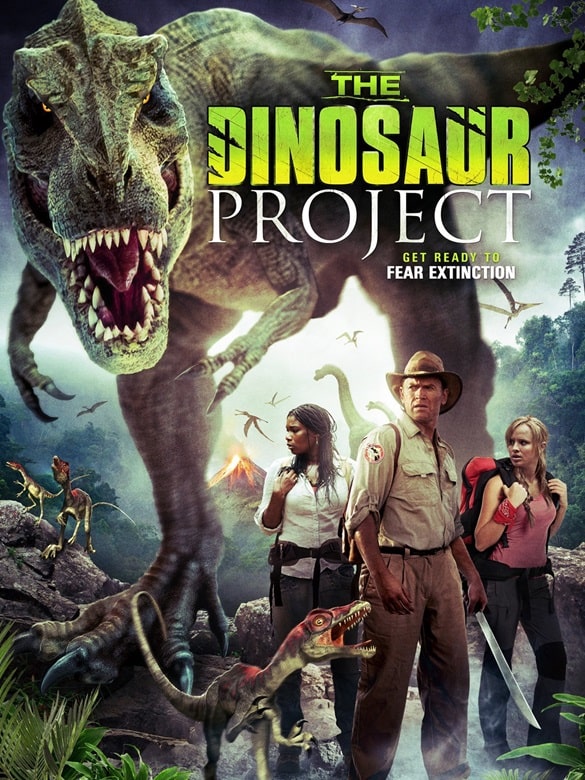
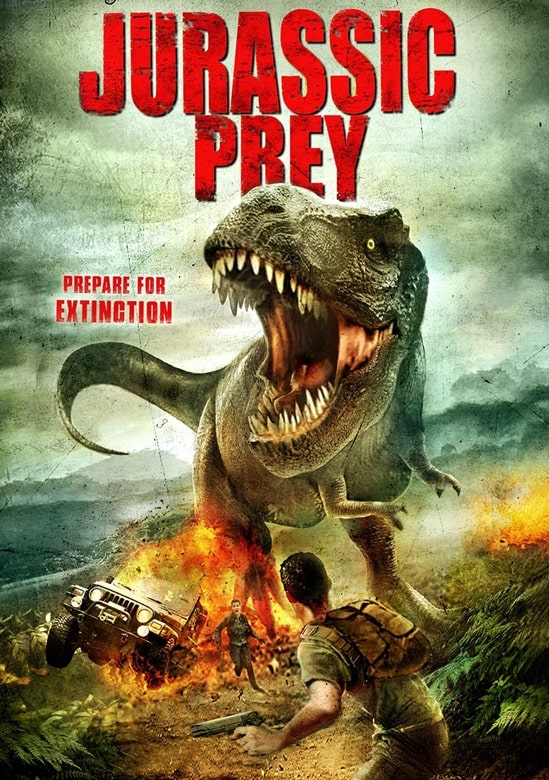
The Dinosaur Project (StudioCanal, 2012), and Jurassic Prey (Polonia Brothers Entertainment, 2015)
Just how bad is the CG? Passable.
Sexy scientist? Almost.
Mumbo jumbo? Hidden African dinosaur valley.
The film began with a shock as the StudioCanal logo popped up — what? You mean this might be half decent?
Almost. Coming off as a Lost World-lite, this had the makings of a decent yarn as a bunch of Brits descend into the African bush in search of Mokele-mbembe, the Congo’s own Nessie. A pterodactyl-tinged helicopter crash dumps them in the Dino-dollops, and the rest of the film is the team trying to survive/being killed one-by-one, all in fantastically annoying ’found footage’ fashion. It’s not terribly exciting, but it’s refreshing to get some real actors and the CG isn’t cringeworthy.
Mostly harmless.
6/10
Jurassic Prey (2015) TubiJust how bad is the CG? The only CG is blood, and it’s rubbish.
Sexy scientist? Nope.
Mumbo jumbo? Mining explosion wakes up a thick T-Rex.
There’s only one phrase worse than ‘A Polonia Brothers Film’, and that’s ’anal seepage’, but I’d take the latter over the former any day of the week.
Everything about this film — the plot, the direction, the editing, the acting, the music, the effects — is hot garbage. The only things I enjoyed were the cankles on the ludicrous dinosaur puppet.
Avoid.
1/10
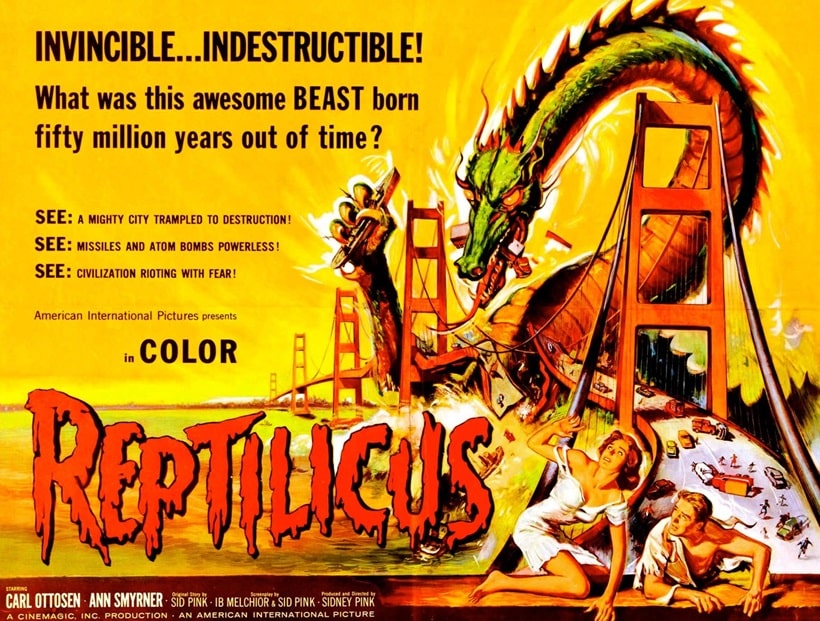 Reptilicus (American International Pictures, 1961)
Reptilicus (1957 or 1961) Tubi
Reptilicus (American International Pictures, 1961)
Reptilicus (1957 or 1961) Tubi
Just how bad is the CG? No CG, but some laughable compositing in the US version.
Sexy scientist? Yep.
Mumbo jumbo? Copper mining digs up a regenerating monster.
And so we reach the end of this miserable excursion with an old one that somehow managed to slip by me, Reptilicus, the first and last Danish/US co-op monster movie. There are two versions, and I would love to find the Danish one, because the AIP US production is pretty awful. They shot the film twice, once in Danish and once in English, but smothered the latter in V.O., and it sounds like the dubbing was done by actors whacked out on cough syrup.
Reptilicus itself is less dinosaur, more Chinese dragon puppet, and it rampages around Denmark laying waste to some nice miniatures of tourist attractions. We know what they are because a couple of characters go on an extended sightseeing trip. All the familiar tropes are in place, including Dr. Frosty McDemiwave, and I enjoyed myself. It’s rubbish, but it’s nostalgic rubbish, and that makes it great.
6/10
Previous Murkey Movie surveys from Neil Baker include:
Prehistrionics, Part I
Prehistrionics, Part II
Jumping the Shark
Alien Overlords
Biggus Footus
I Like Big Bugs and I Cannot Lie
The Weird, Weird West
Warrior Women Watch-a-thon
Neil Baker’s last article for us was Prehistrionics, Part II. Neil spends his days watching dodgy movies, most of them terrible, in the hope that you might be inspired to watch them too. He is often asked why he doesn’t watch ‘proper’ films, and he honestly doesn’t have a good answer. He is an author, illustrator, outdoor educator and owner of April Moon Books (AprilMoonBooks.com).
RIP Howard Andrew Jones
 John O’Neill and Howard Andrew Jones at the World Science Fiction Convention, Washington DC, December 19, 2021
John O’Neill and Howard Andrew Jones at the World Science Fiction Convention, Washington DC, December 19, 2021
Howard Andrew Jones is dead.
It’s hard to write those words. Howard has been a huge part of my personal and professional life since 2002, when I opened a submission to Black Gate magazine and found a long, rambling, and extremely enthusiastic cover letter from him, expressing his delight at finding a quality magazine devoted to heroic fantasy. The letter ended with “I want in, bad,” and was attached to a terrific tale featuring two adventurers named Dabir and Asim.
We eventually published three Dabir and Asim tales in Black Gate, and within a few years Howard’s editorial contributions had become so essential to the magazine that we named him our first Managing Editor. He ran our non-fiction department, single-handedly recruiting and managing over a dozen contributors to fill some 80 pages every issue with thoughtful essays, book reviews, gaming coverage, and much more.
 The Ring-Sworn Trilogy by Howard Andrew Jones (St. Martin’s Press, 2018-2021). Covers by Lauren Saint-Onge
The Ring-Sworn Trilogy by Howard Andrew Jones (St. Martin’s Press, 2018-2021). Covers by Lauren Saint-Onge
In November 2008 Howard told me he wanted to remake our website, and post new articles every single day, instead of a few times a month. I told him he was crazy. How in the world could we produce that much content, especially without a budget?
Undaunted, Howard put together a top-notch team of writers, and committed to putting daily content on the Black Gate blog. It was his vision, and he executed it magnificently, with a little help from Bill Ward, David Soyka, Scott Oden, James Enge, EE Knight, Ryan Harvey, and others. Eight years later, the website won a World Fantasy Award — an honor that I still believe should have been presented to Howard.
Before long Howard’s own writing career had taken off with such magnitude that he had to step back from day-to-day duties at the magazine. Over the next fifteen years he released fifteen books, including three featuring Dabir and Asim, four novels in the Pathfinder universe, the Ring-Sworn Trilogy, three volumes in The Chronicles of Hanuvar, and the Harold Lamb collections Swords from the East and Swords from the West.
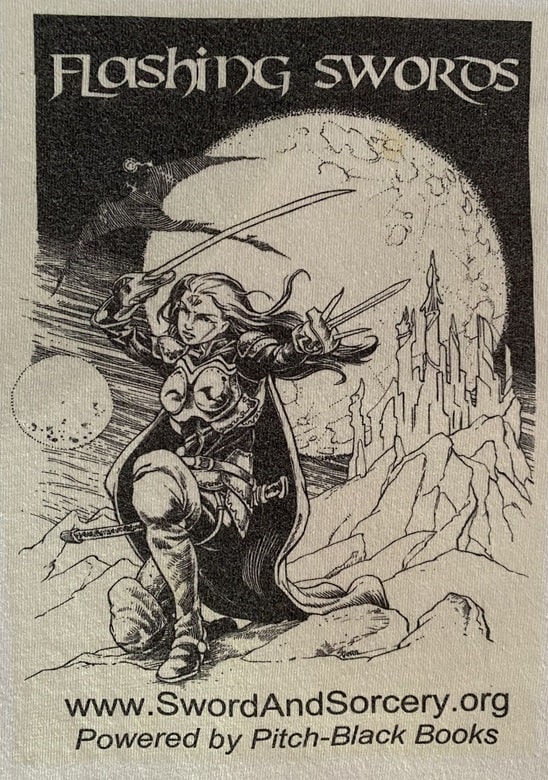 The Flashing Sword sZine, edited by Howard Andrew Jones (2006-2007)
The Flashing Sword sZine, edited by Howard Andrew Jones (2006-2007)
Howard was a wonderful writer. He believed in heroes, and that steadfast conviction informed all of his writing. But despite all his success Howard never lost touch with his other major talent — finding and nurturing new writers. Howard was an enormously gifted editor, and a tireless champion of underappreciated writers. It was a gift that led to his first editing gig in 2005, running Flashing Swords ezine for Daniel Blackston at Pitch-Black Books, an underfunded online magazine that produced six excellent issues in 2005 and 2006.
Howard’s accelerating career brought him countless additional opportunities, but the ones he seized were usually the ones that gave him the chance to find and publish new talent. Joseph Goodman brought Howard onboard to launch Tales From the Magician’s Skull at Goodman Games in 2017, and with Howard at the helm the magazine quickly became the premiere outlet for modern sword & sorcery and heroic fantasy. Howard got the band back together for the Skull, recruiting much of the same talent he’d called upon at Black Gate — including Bill Ward, John C. Hocking, James Enge, Chris Willrich, Mark Rigney, and many others.
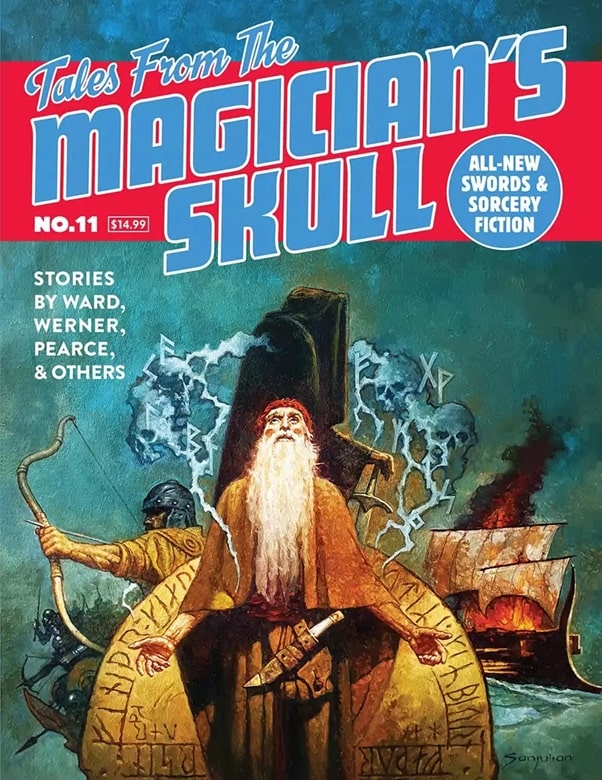 Tales From the Magician’s Skull #11, edited by Howard Andrew Jones (Goodman Games, October 1, 2022). Cover by Sanjulian
Tales From the Magician’s Skull #11, edited by Howard Andrew Jones (Goodman Games, October 1, 2022). Cover by Sanjulian
Back in 2011 Howard sent me the draft of a new story he was working on. It featured a new hero, the last general of a defeated people. His name was Hanuvar, and he was consciously modeled on one of Howard’s heroes, the great Carthaginian general Hannibal, whom Howard has first encountered in a Harold Lamb novel. The story was both more sober and more ambitious than anything Howard had sent previously, and I knew instantly that I wanted to publish it in Black Gate.
Alas, I never got the chance. Black Gate magazine folded in 2011, and that was the end of my editing career. Howard found a home for his Hanuvar stories in magazines like Adrian Simmons’ Heroic Fantasy Quarterly, and Tales from the Magician’s Skull, and fine anthologies like Jason Waltz’s Neither Beg Nor Yield. Eventually they were collected in 2023 in Lord of a Shattered Land, a volume that relaunched Howard’s career and put him in front of countless new fantasy fans.
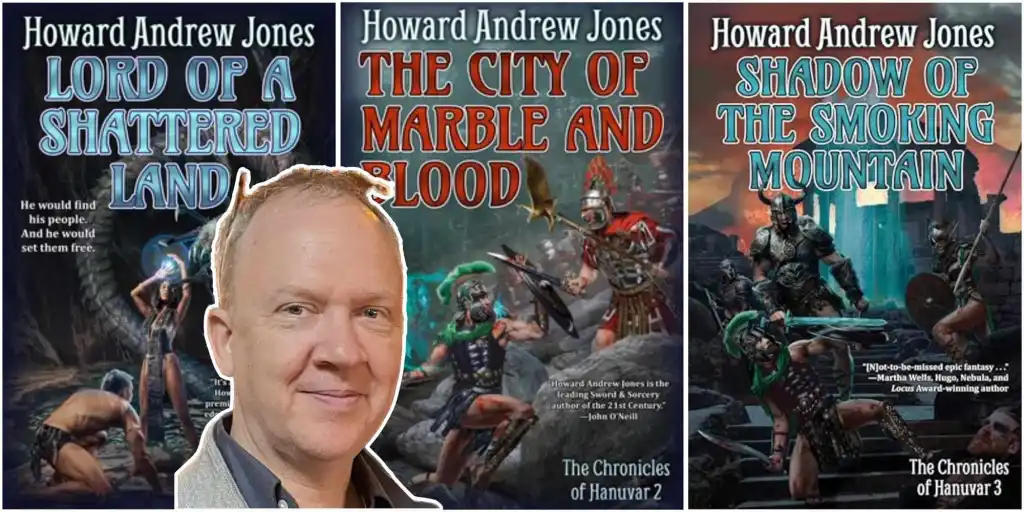 The Chronicles of Hanuvar by Howard Andrew Jones (Baen Books, 2023-2024). Covers by Dave Seeley
The Chronicles of Hanuvar by Howard Andrew Jones (Baen Books, 2023-2024). Covers by Dave Seeley
Baen Books signed Howard to a five-book contract for Hanuvar, and on his way home from Gen Con this summer, Howard called to let me know that Baen had agreed to extend his contract for an additional two volumes. Howard had nearly finished book four, and had grand plans to extend the series to add in several new storylines. He was as upbeat about his writing career as I’d ever heard him, and I was overjoyed to hear it. Howard had found his audience at last, and a publisher who could help him reach it. The world was finally starting to notice just what a talented writer he was.
Just a few weeks later, Howard called to tell me that he was experiencing a strange leg pain. He blamed it on not doing morning stretches before long writing bouts on the kitchen stool. The ailments spread over the next month, and in late September Howard was diagnosed with glioblastoma. Terminal brain cancer. He passed away at home in Evanston, Indiana, at 12:15 am yesterday night.
It’s hard for me to understand that I won’t talk to Howard again. That I won’t get eight-minute phone calls from him as he’s dashing to pick up groceries. That we won’t talk about writing and pulp fiction and Star Trek for long hours. That he won’t be at the center of our raucous annual dinner gatherings at Windy City Pulp & Paper. That I won’t sit on the porch and gossip about whose book series just got canceled, who’s making waves in the industry, who’s the best fantasy writer not named Howard Andrew Jones.
I loved him. And now he’s gone. I don’t understand. The world isn’t fair, but I know exactly what Howard would tell me. Keep writing. And don’t let it get you down.
Here’s to you, Howard. You were the best of us, and you’ve been taken away. You fought tirelessly to make sure the world didn’t cruelly forget the writers you respected, like Harold Lamb, Leigh Brackett, and Roger Zelazny. Now it’s time to lay down your pen, douse the lamps in your wind-swept tower, and let others take up the fight.
Rest well, my friend. You’ve earned it.
Goth Chick News: Hitting the Show Circuit Hard in 2025
 This is why BLACK GATE gives out press passes
This is why BLACK GATE gives out press passes
And so this happened last week…
John O (the big cheese): People probably imagined you lot (Photog Chris Z and I presumably) are just hunkered down there in the subterranean offices of Black Gate sequestered with a blender, several bottles of adult beverages and the Roku horror channels.
Me: So…?
John O: So – that’s not the image we want to portray here at Black Gate.
Me: We have an image?
John O: OF COURSE WE HAVE AN IMAGE! Why can’t you be more like Bob Byrne?
Me: Bob? Oh… you mean Sherlock. Right. Wait, what was that first thing again?
John O: [insert unpublishable adult language] Would you please just go be visible somewhere? Be a reporter – get out in the field and report. That’s what Bob does. He reports… on detectives… for Black Gate.
Me: The ice machine is broken again.
John O: ARG! [insert more adult language and stomping up the stairs]
What John O doesn’t know but what — and I’m just guessing here — he wants to know, is the following.
About the time “the season” has officially concluded for Goth Chick News (and the season runs from March through November), we have a short holiday break before plunging headfirst into a new annual show circuit: hell bent on bringing you the warmest, moistest, gooiest news from the underside of pop culture.
This year the 2025 circuit kicks off with the Halloween & Attractions Show, followed by Days of the Dead’s first trip through Chicago. From that point forward it’s all go here at Goth Chick News, with a couple of new events thrown in this year.
The Halloween & Attractions Show: Feb 27-Mar 2 (Industry only)
Days of the Dead Convention Chicago: Mar 28-30
Chicago Comic and Entertainment Expo (C2E2): April 11-13
Nightmare Weekend: May 2-4
The Midwest Haunter’s Convention: June 6- 8
American Hauntings Conference: June 26-29
Fan Expo: Aug 15-17
Days of the Dead Convention Chicago: November TBD
So photog Chris Z and I do get out of the office. Okay, it is mostly at night and mostly with people carrying around body parts and stuff, but that shouldn’t matter.
We can’t all be Bob.
The Masters of Narrative Drive
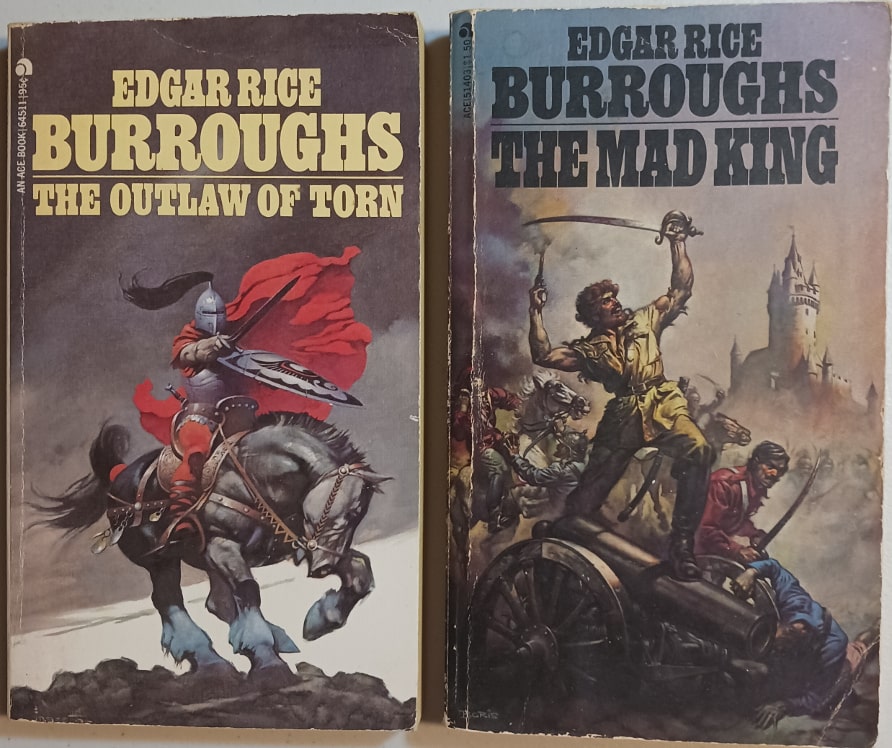 The Outlaw of Torn and The Mad King by Edgar Rice Burroughs (Ace Books, January 1973 and February 1979). Covers by Frank Frazetta and Boris Vallejo
The Outlaw of Torn and The Mad King by Edgar Rice Burroughs (Ace Books, January 1973 and February 1979). Covers by Frank Frazetta and Boris Vallejo
An author friend of 70+ books told me that a novel is just “one damned thing after another.” This is a layman’s way of saying that a book needs “narrative drive.” Narrative drive keeps readers turning the pages. It exerts a pull that drags the reader along. Edgar Rice Burroughs was the master of narrative drive. Things are happening on every page of his books that keep you wanting to know more.
There are two primary kinds of “wanting to know more.” One is, more information about the story’s plot. This is based on intellectual curiosity, and mystery stories illustrate this most clearly. Who committed the murder? Why? How? Etc. This is the primary type of drive that good nonfiction has.
The second kind of “wanting to know more” is based on emotion and character. What is going to happen to a particular character or characters the reader is attached to? The strongest narrative drive combines these.
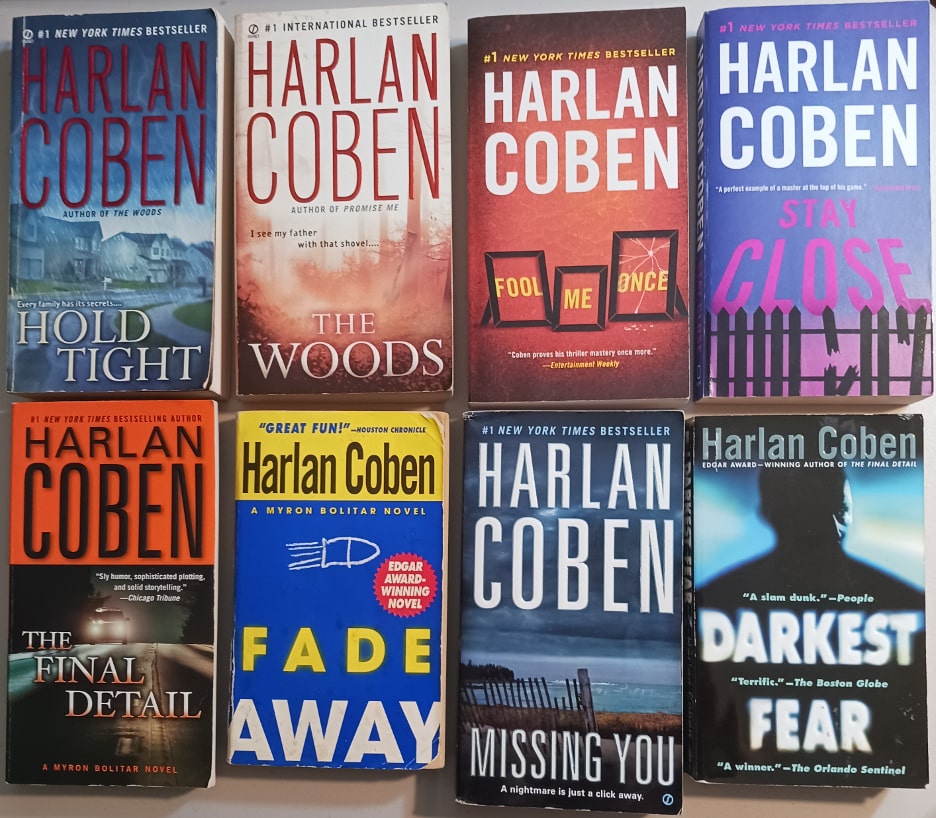 The Novels of Harlan Coben, a master of Narrative Drive
The Novels of Harlan Coben, a master of Narrative Drive
A modern author who captures both qualities — in my opinion — is Harlan Coben. Coben sets up a mystery early. Say, a character’s young brother or sister disappeared many years ago and is believed dead. But now something happens that suggests they may still be alive. This engages intellectual curiosity? How could that be? What happened to them? Where have they been?
As the story goes on, however, Coben works to get you to care about the main characters, to feel their pain. And now you want the mystery to be solved for their sake too.
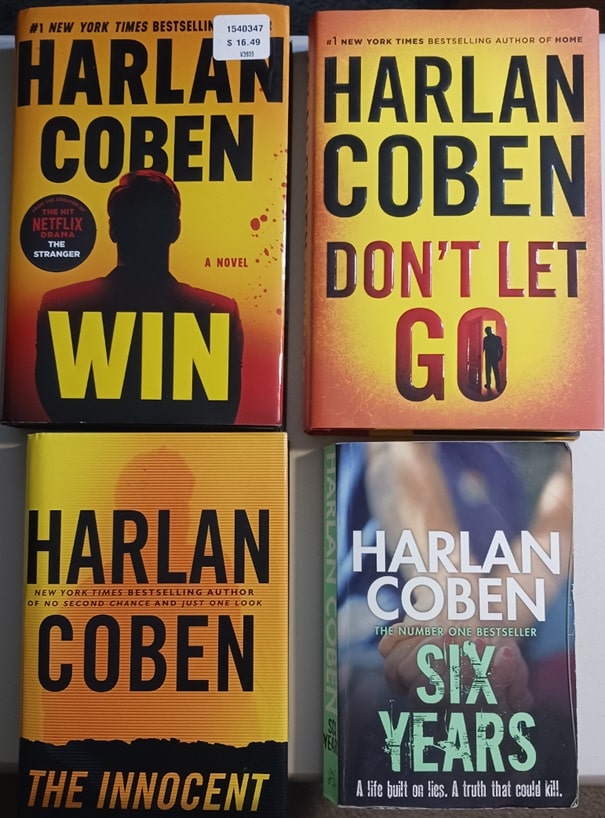 More books by Harlan Coben
More books by Harlan Coben
Such authors as Edgar Rice Burroughs and Robert E. Howard were generally able to create both types of narrative drive in their stories as well. As a young man reading about John Carter or Conan, I identified with these characters. I pictured myself in their shoes so whatever happened to them evoked emotions — fear, anger, desire, joy, melancholy. I wanted them to be successful in the story because I wanted to be successful myself.
At the same time, when these characters discovered a lost city, I wanted to know who’d built it? And why? Were any of them still around? What kind of dangers lurked in the ruins?
At age sixty-five, I find it less easy to identify with characters like Carter and Conan. They’re so different from me. I’m no sword slinging hero. Often, these days, I find myself very interested in the supporting characters, like “Sola,” the female green Martian from A Princess of Mars, or “Woola,” who becomes John Carter’s loyal animal companion.
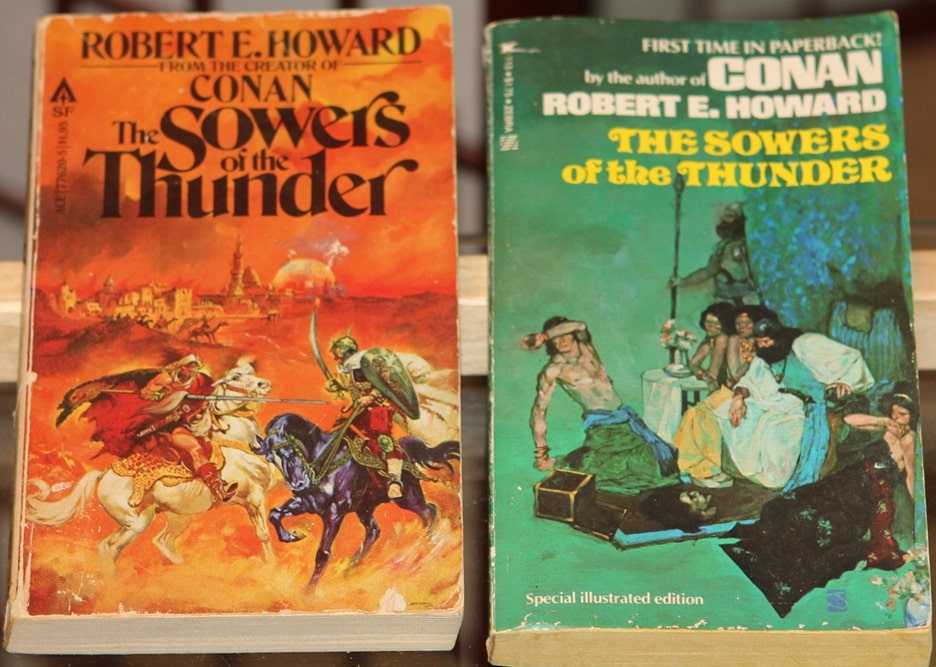 Two editions of The Sowers of the Thunder by Robert E. Howard (Ace Books, July 1979 and Zebra Books, March 1975). Covers by Esteban Maroto and Jeff Jones
Two editions of The Sowers of the Thunder by Robert E. Howard (Ace Books, July 1979 and Zebra Books, March 1975). Covers by Esteban Maroto and Jeff Jones
But I’ve never lost my intellectual curiosity about lost cities and lost worlds. Maybe I’m grown up, but there’s still a lot of “boy” in me, and good Sword & Planet fiction sure entertains that boy.
Above are some books filled with narrative drive, a few of the many Harlan Coben books I’ve read, Outlaw of Torn and The Mad King by ERB, with covers by Frazetta and Boris respectively, and my favorite REH collection, The Sowers of the Thunder, a collection of his crusader stories. Both are full of Roy Krenkel illustrations but the green cover is by Jeff Jones and the orange cover by Esteban Moroto.
Charles Gramlich administers The Swords & Planet League group on Facebook, where this post first appeared. His last article for Black Gate was a look at William R. Forstchen’s The Lost Regiment.

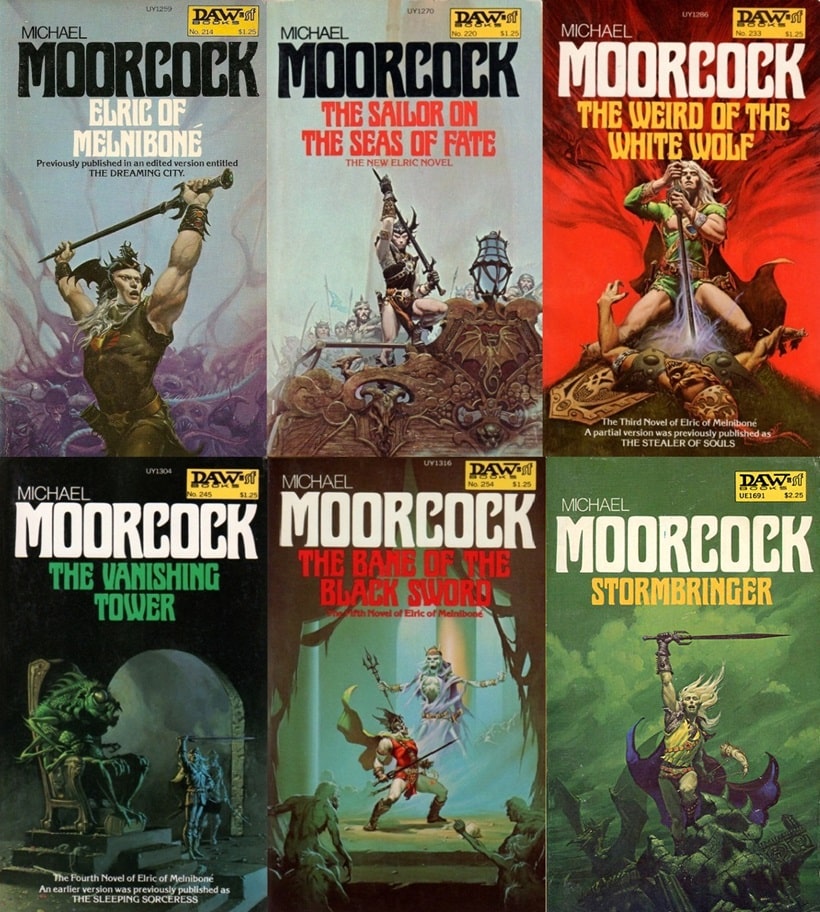

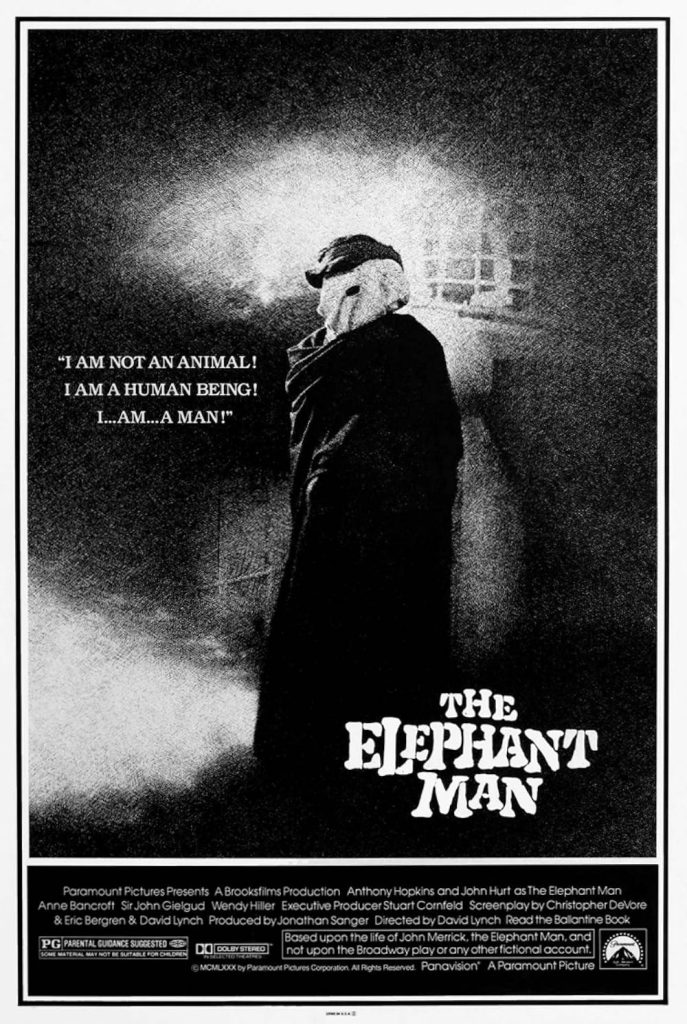

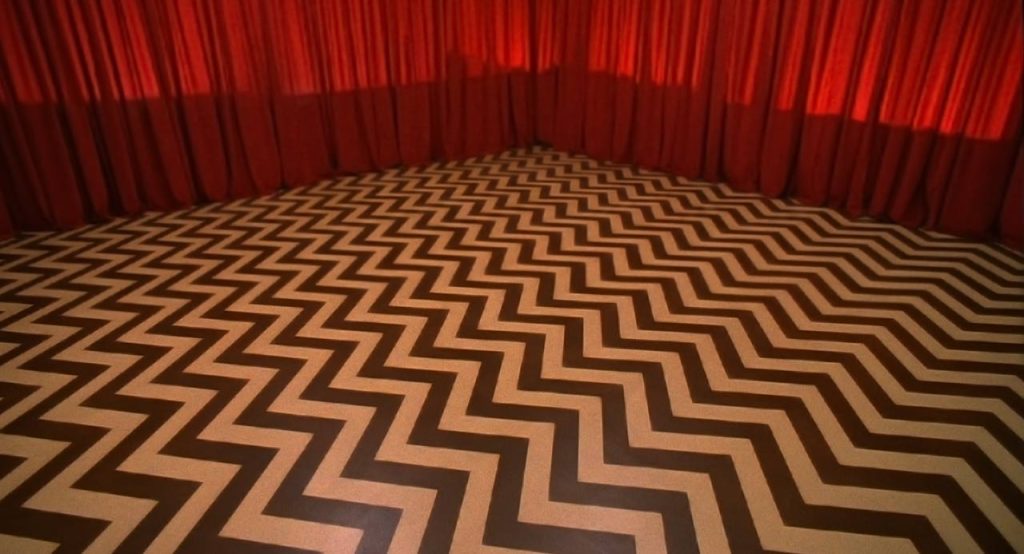
Recent comments